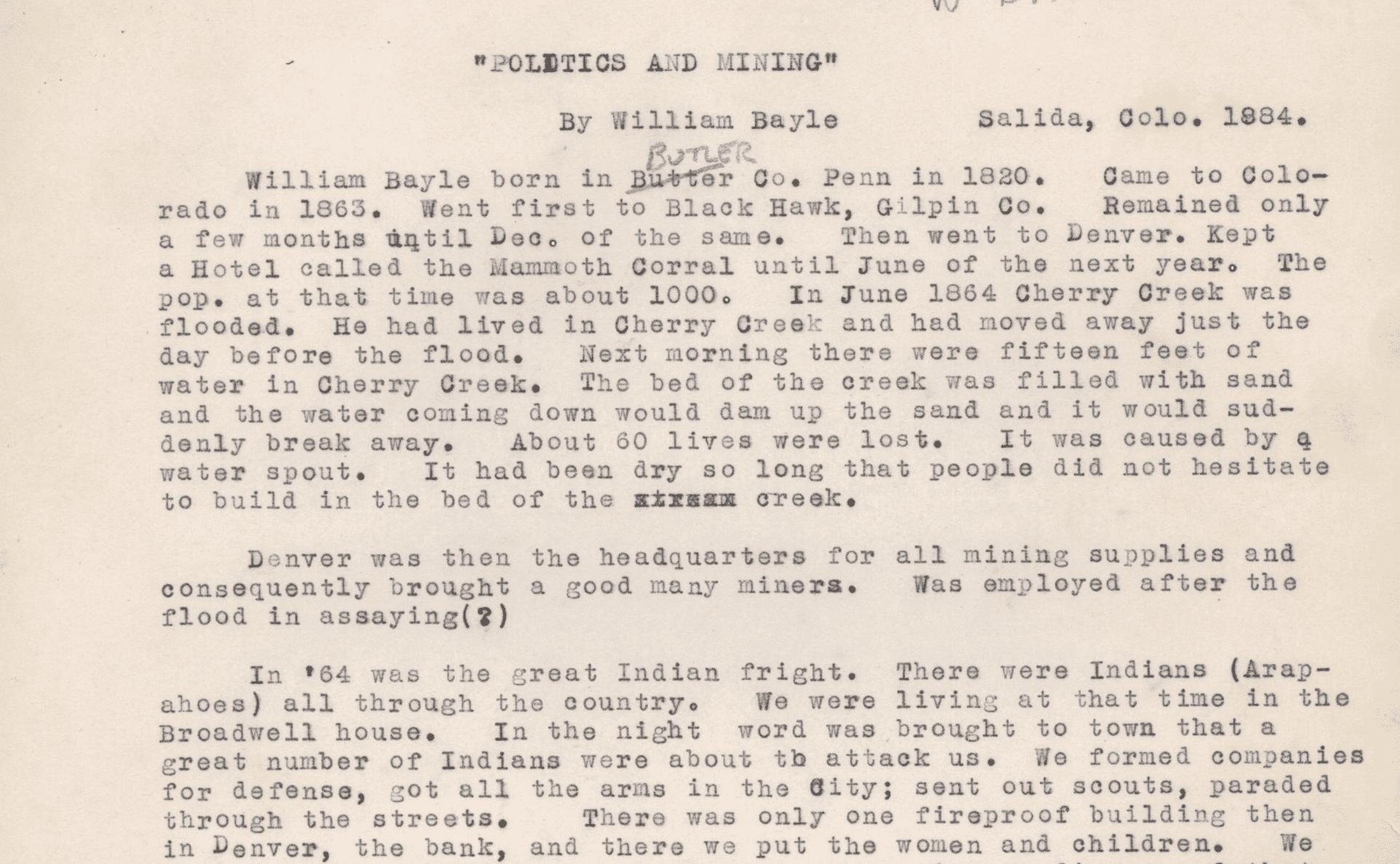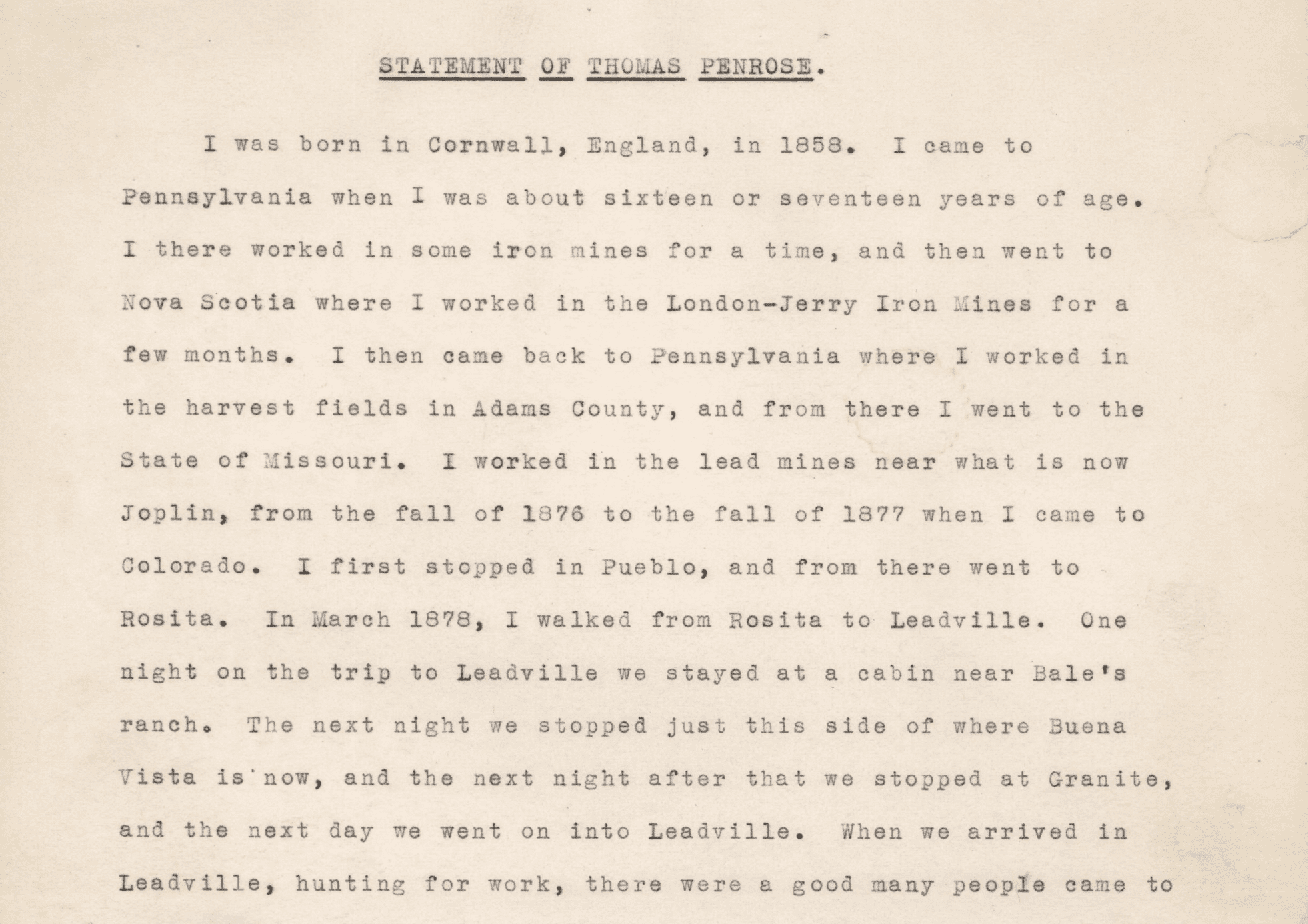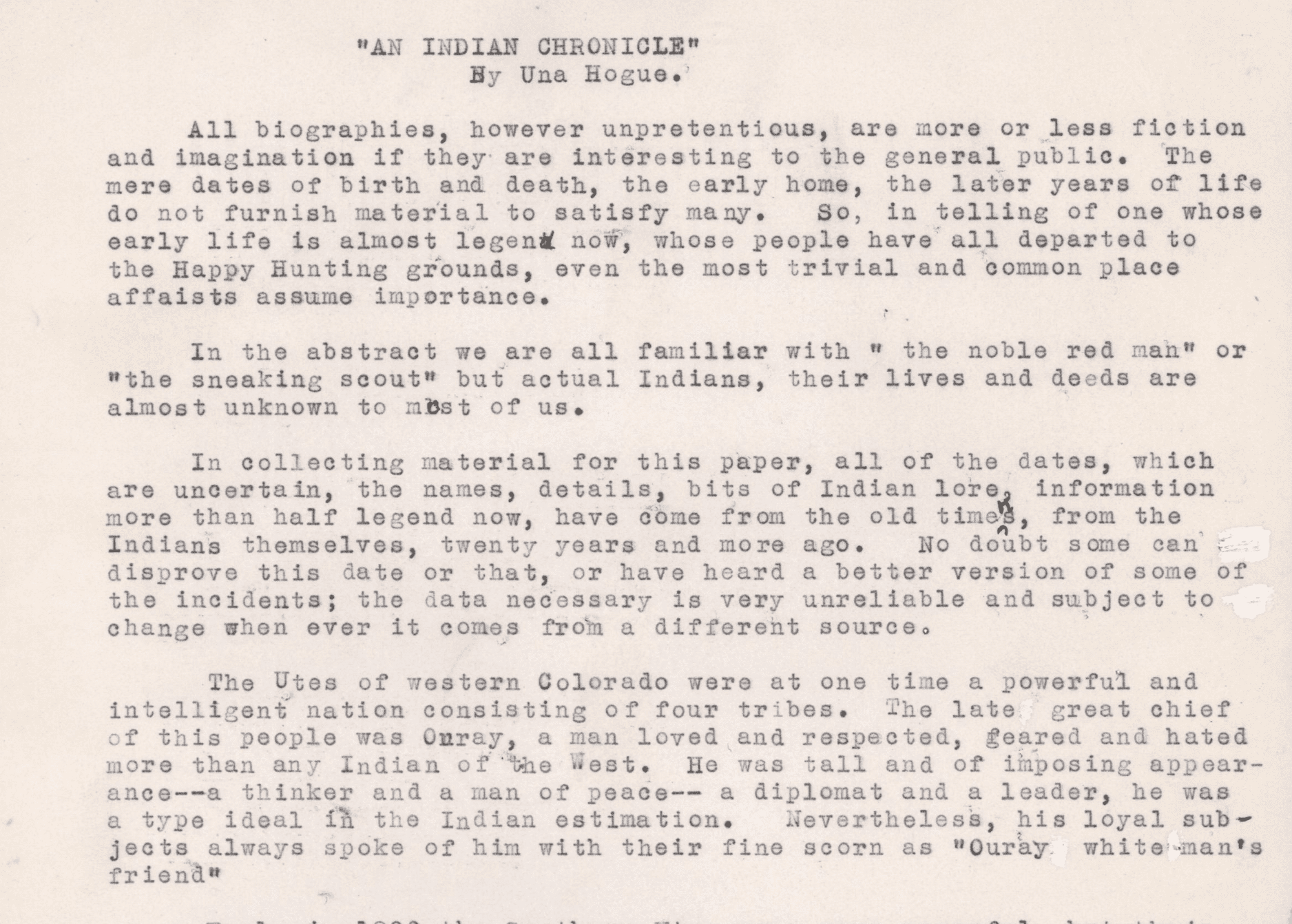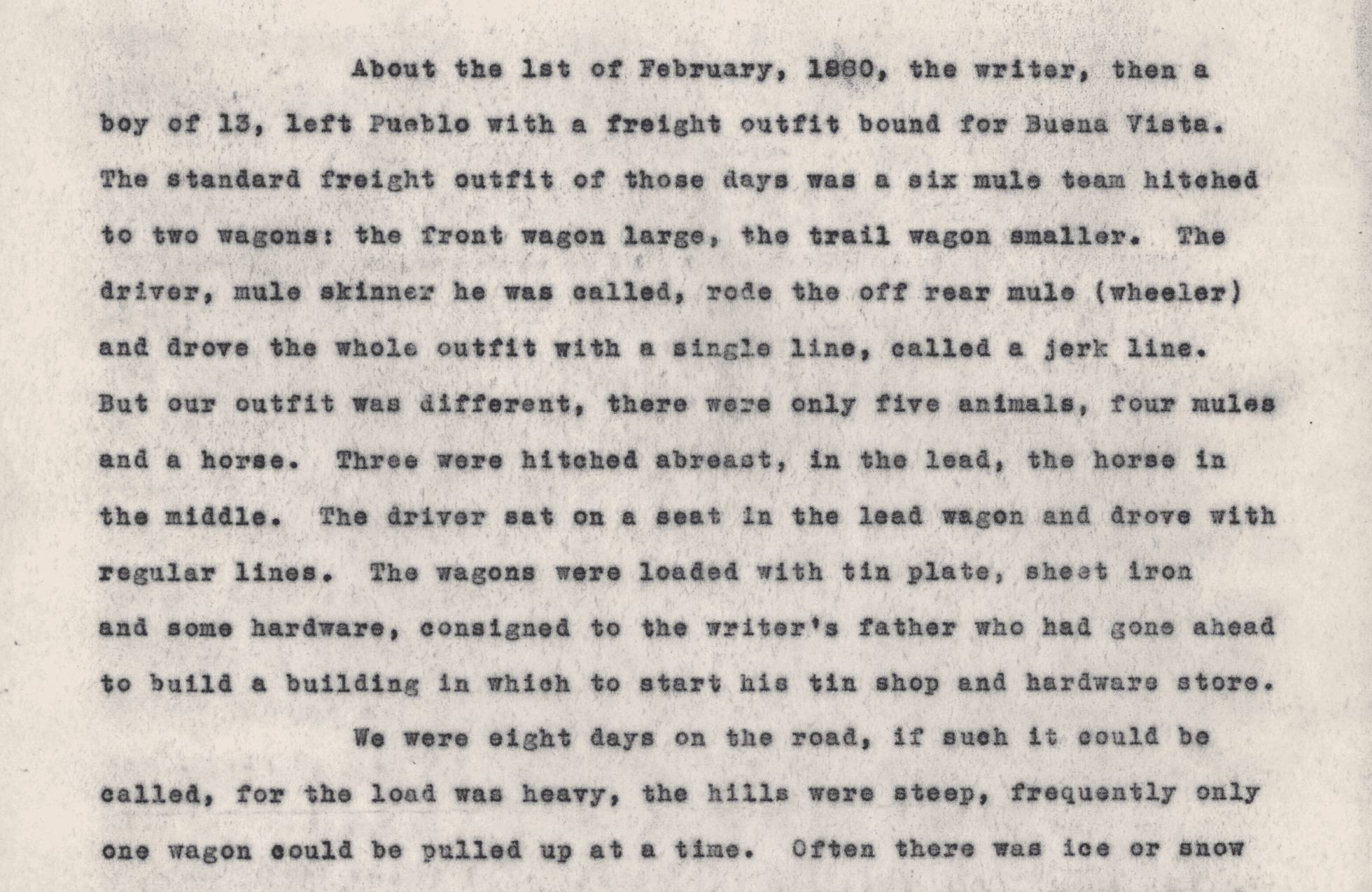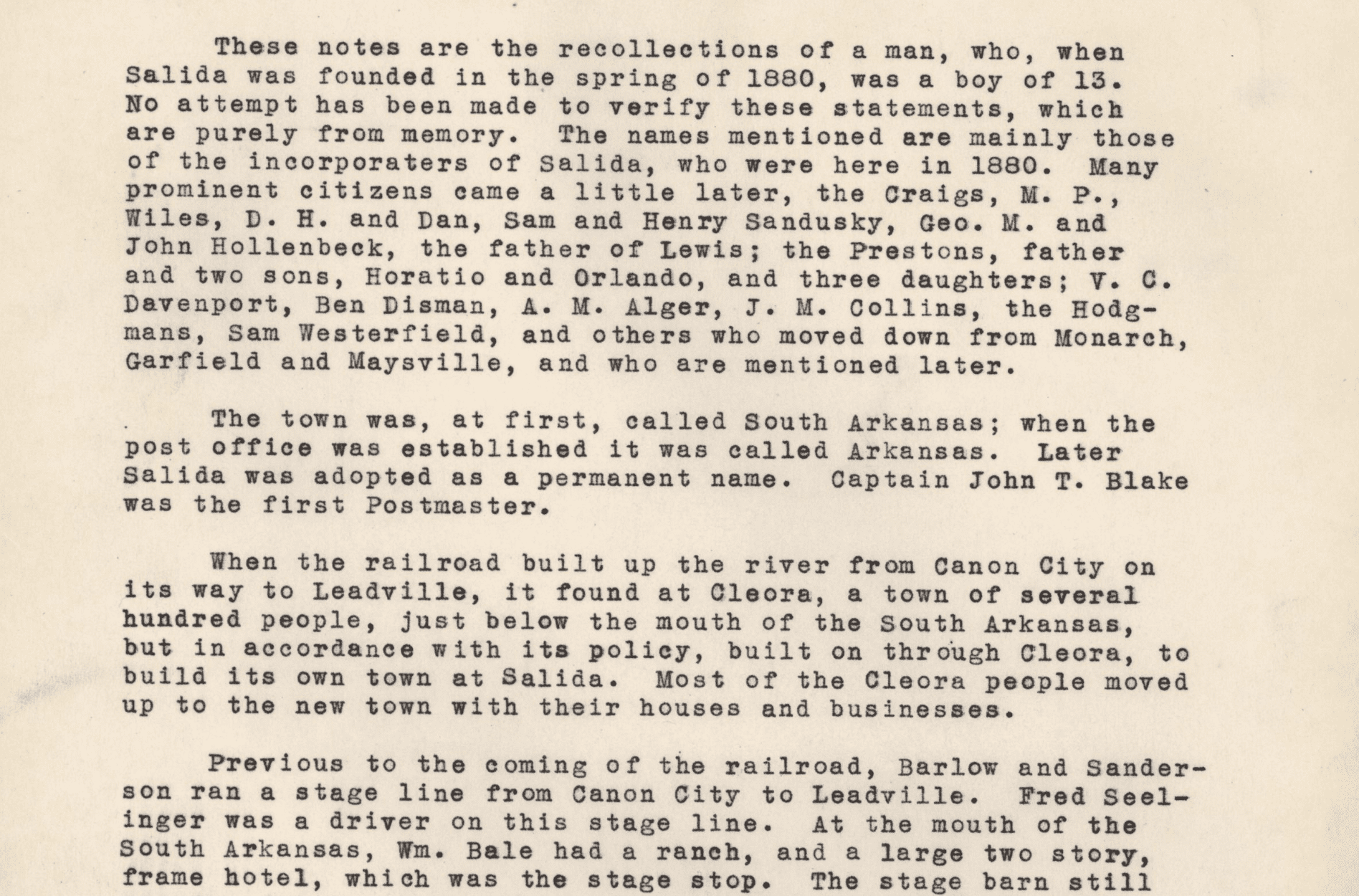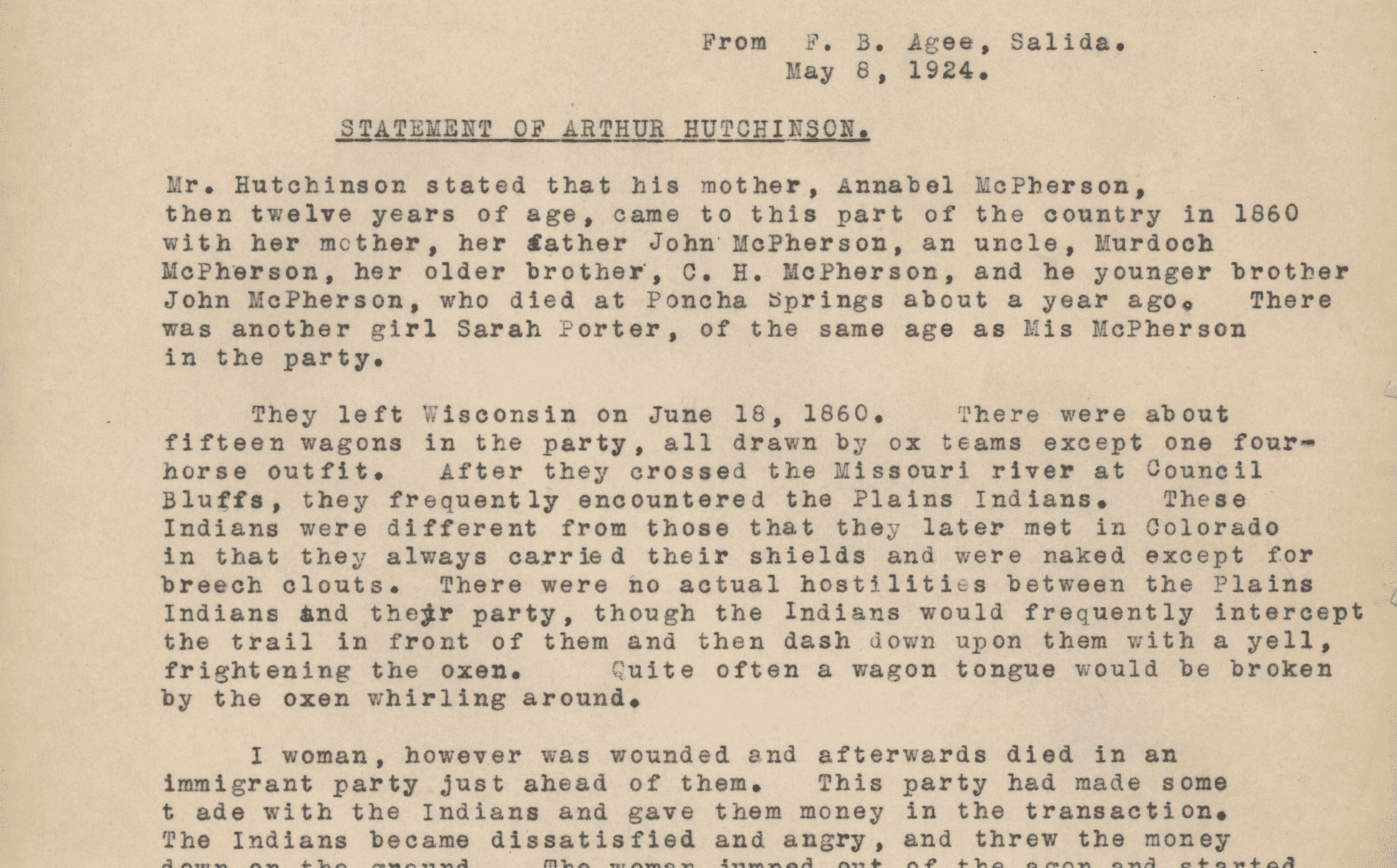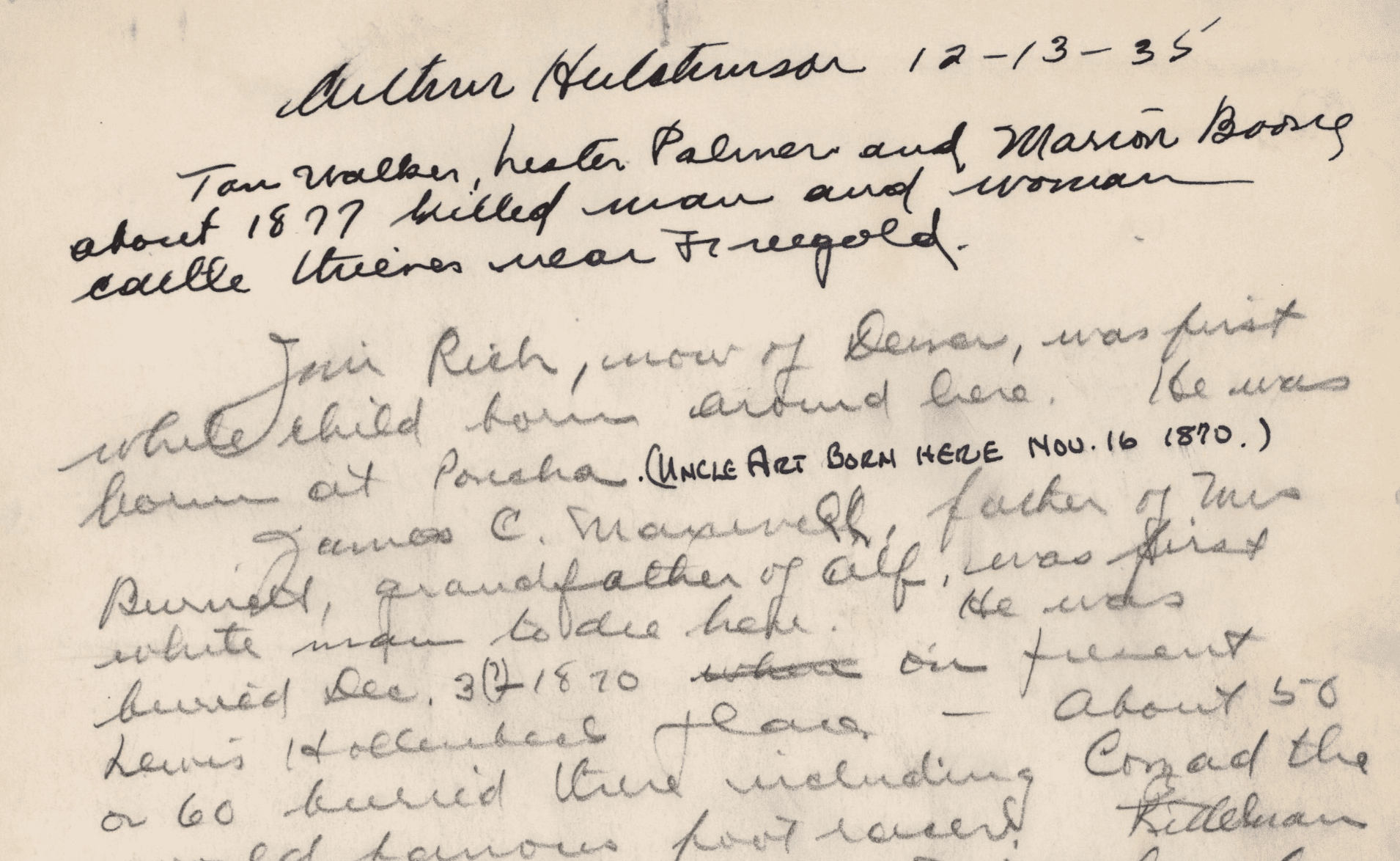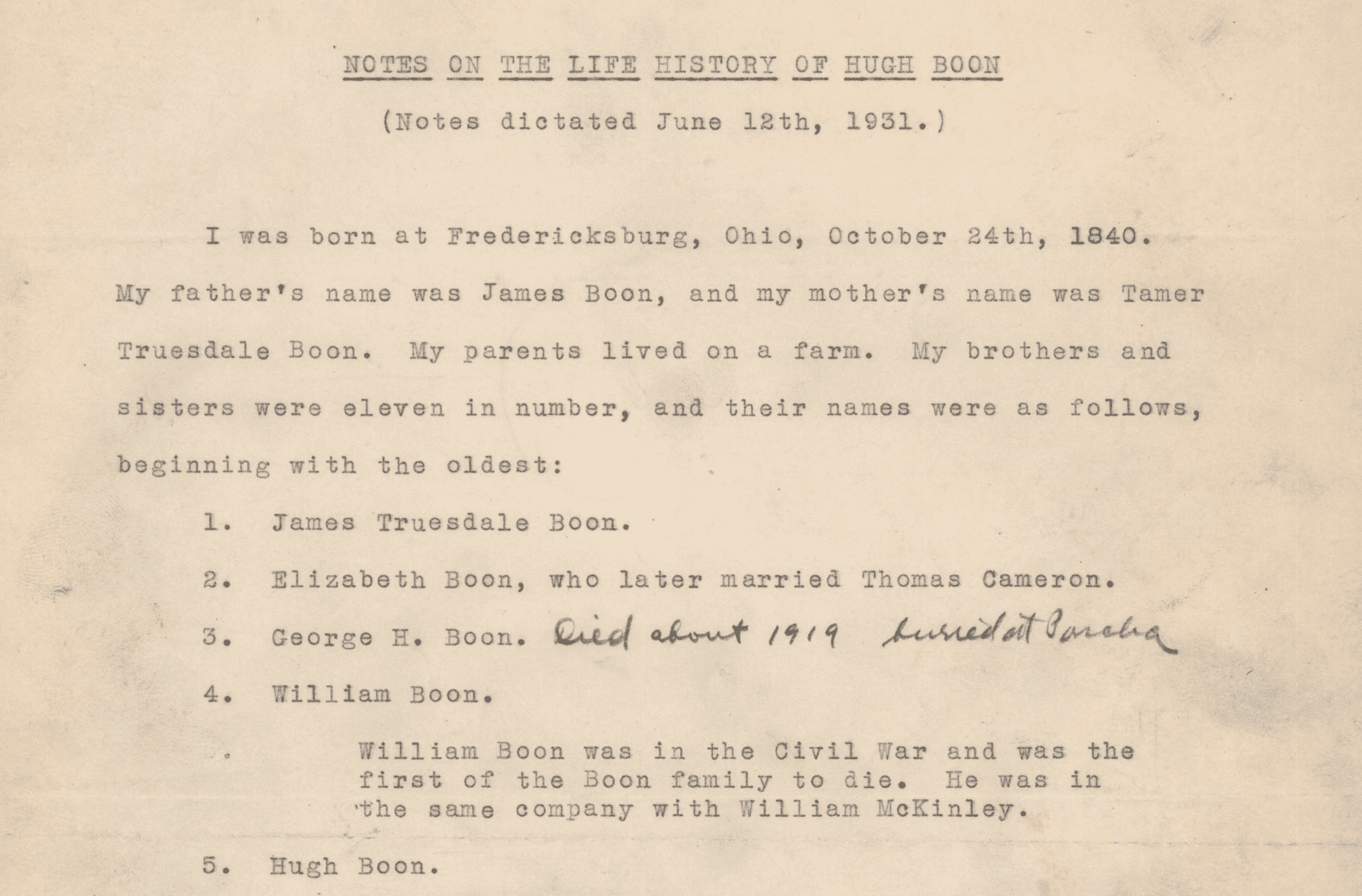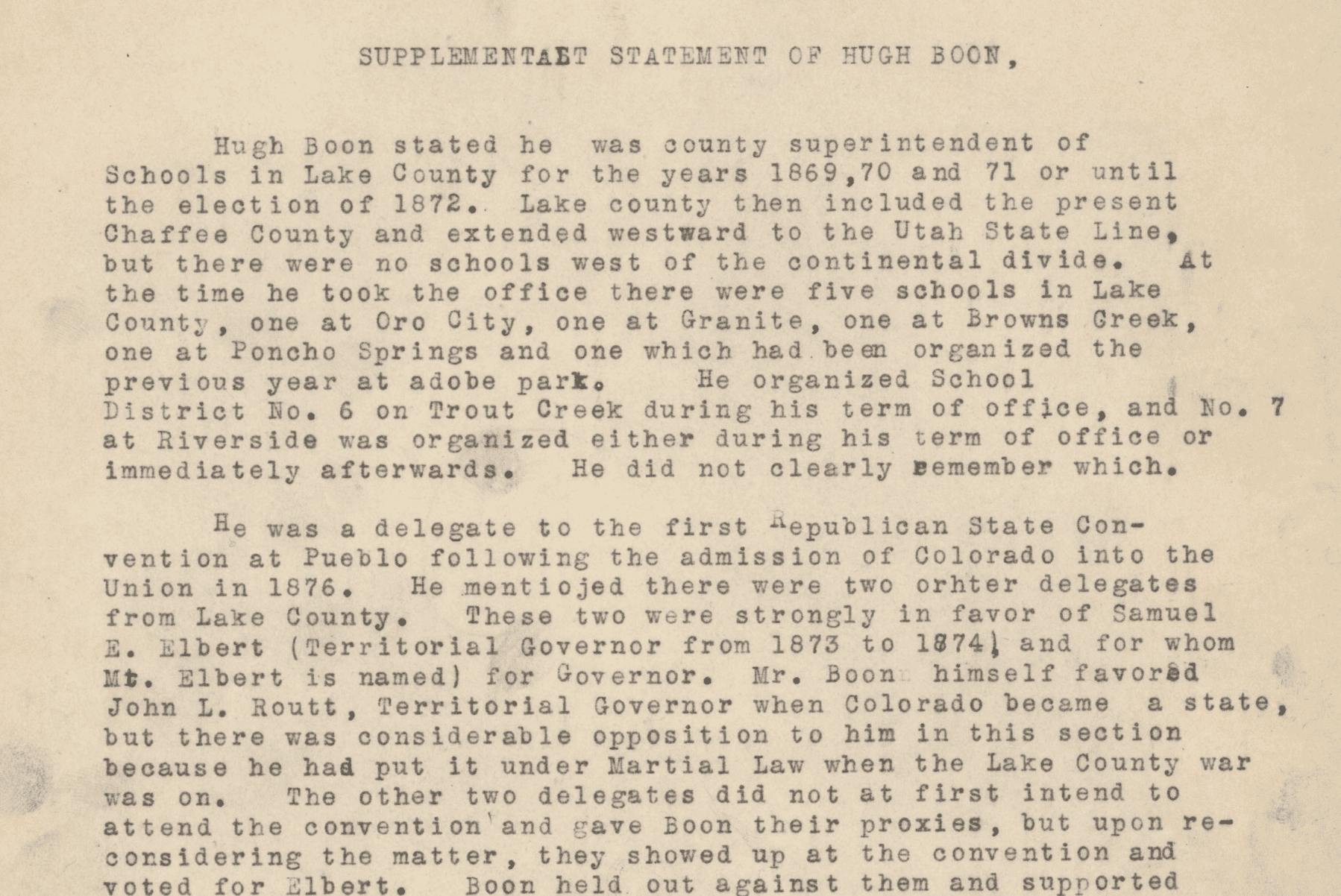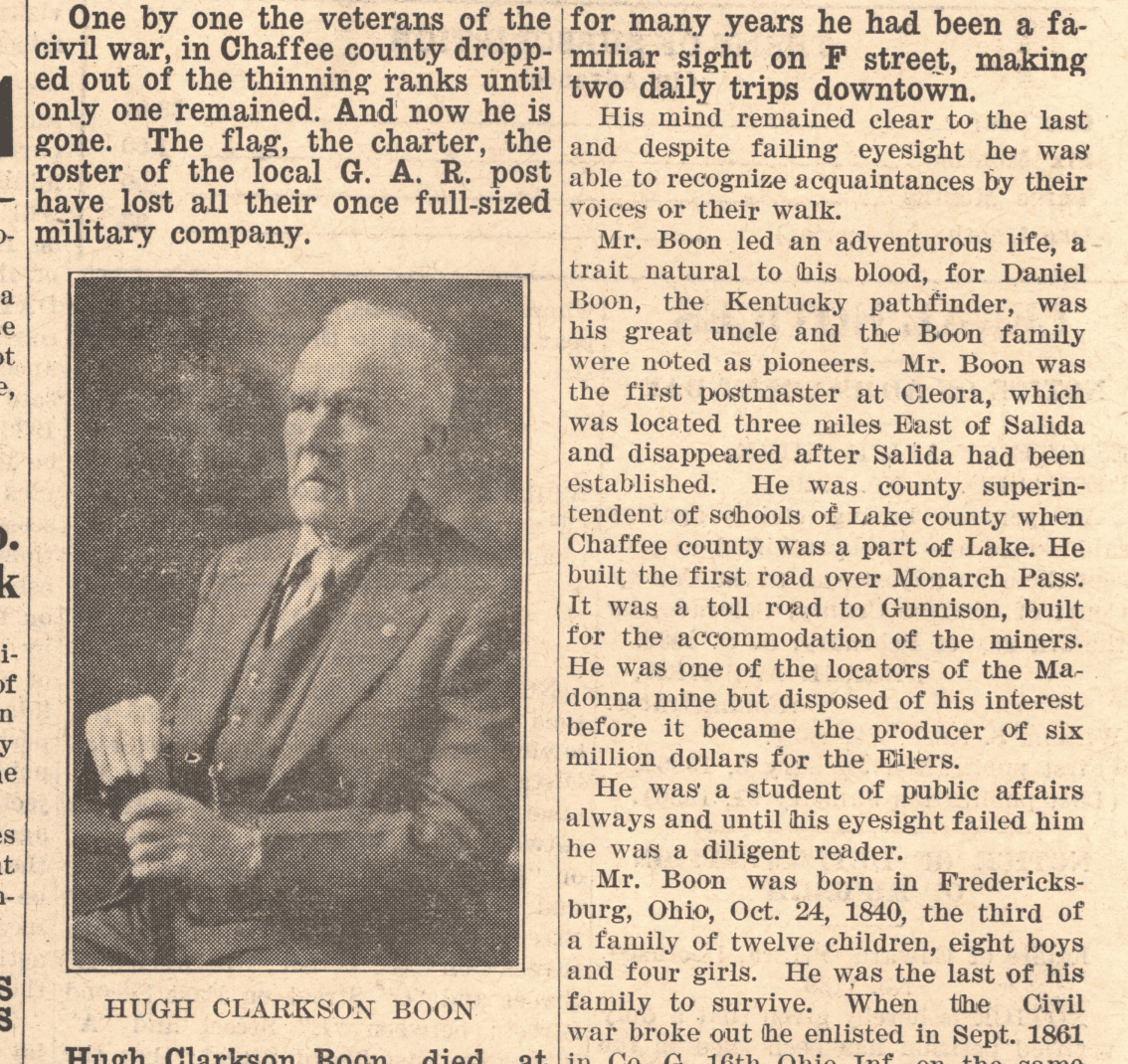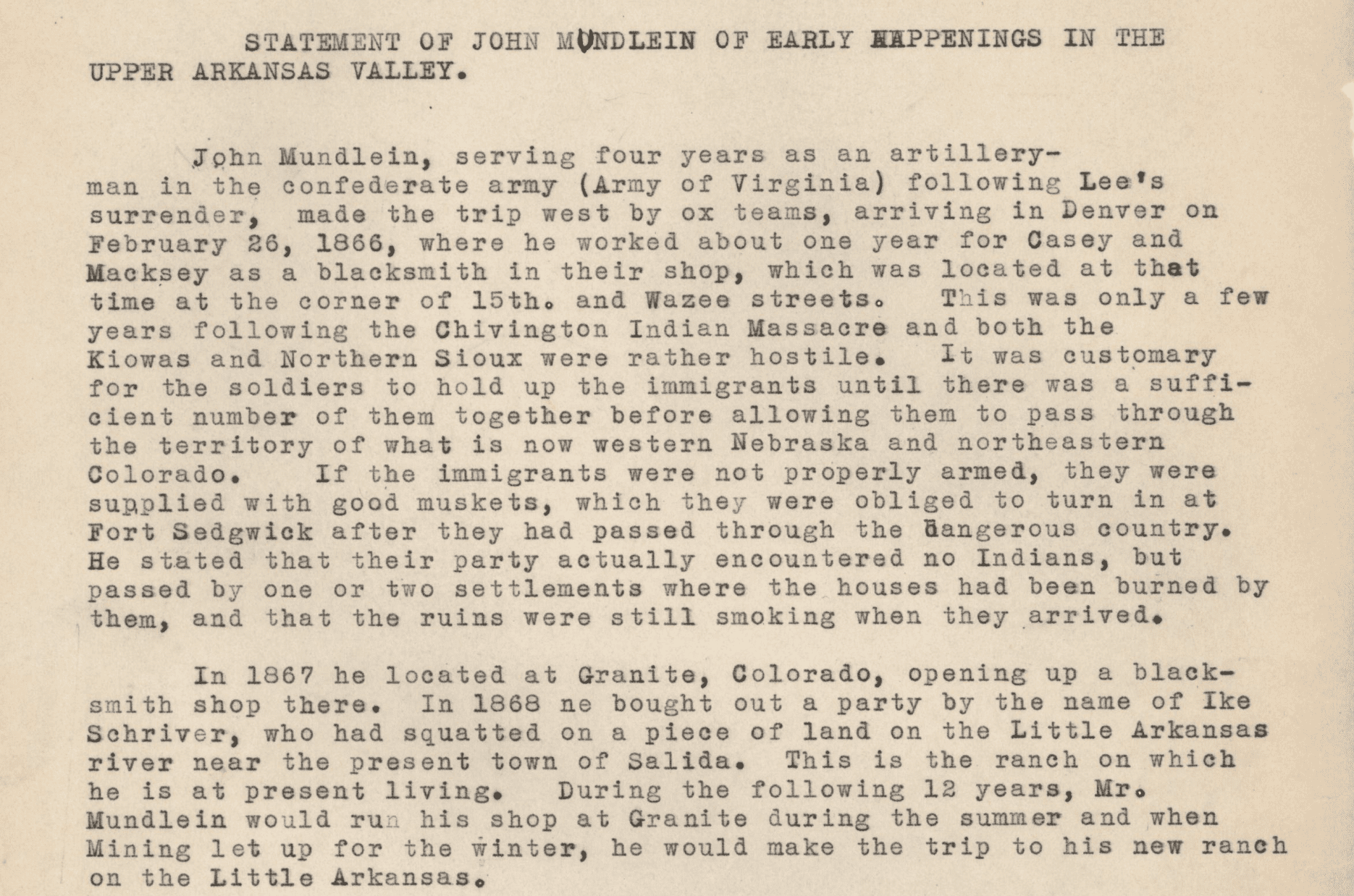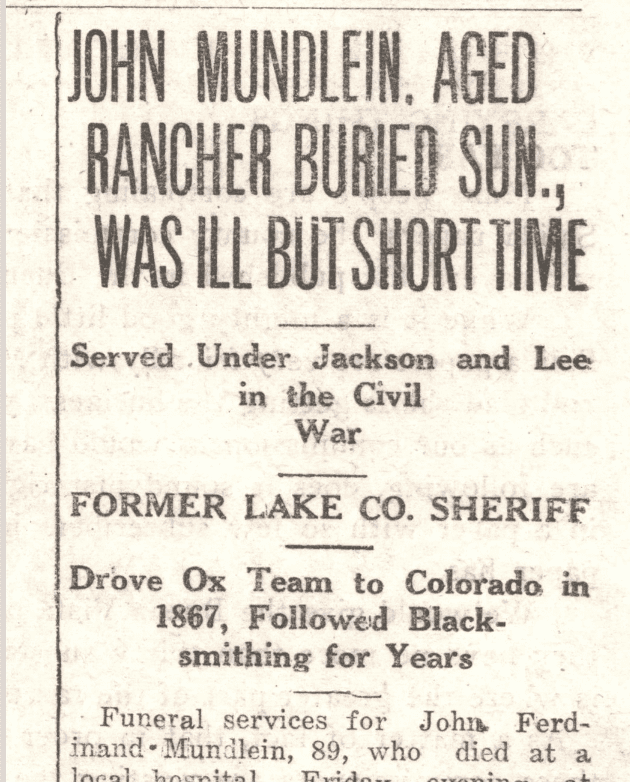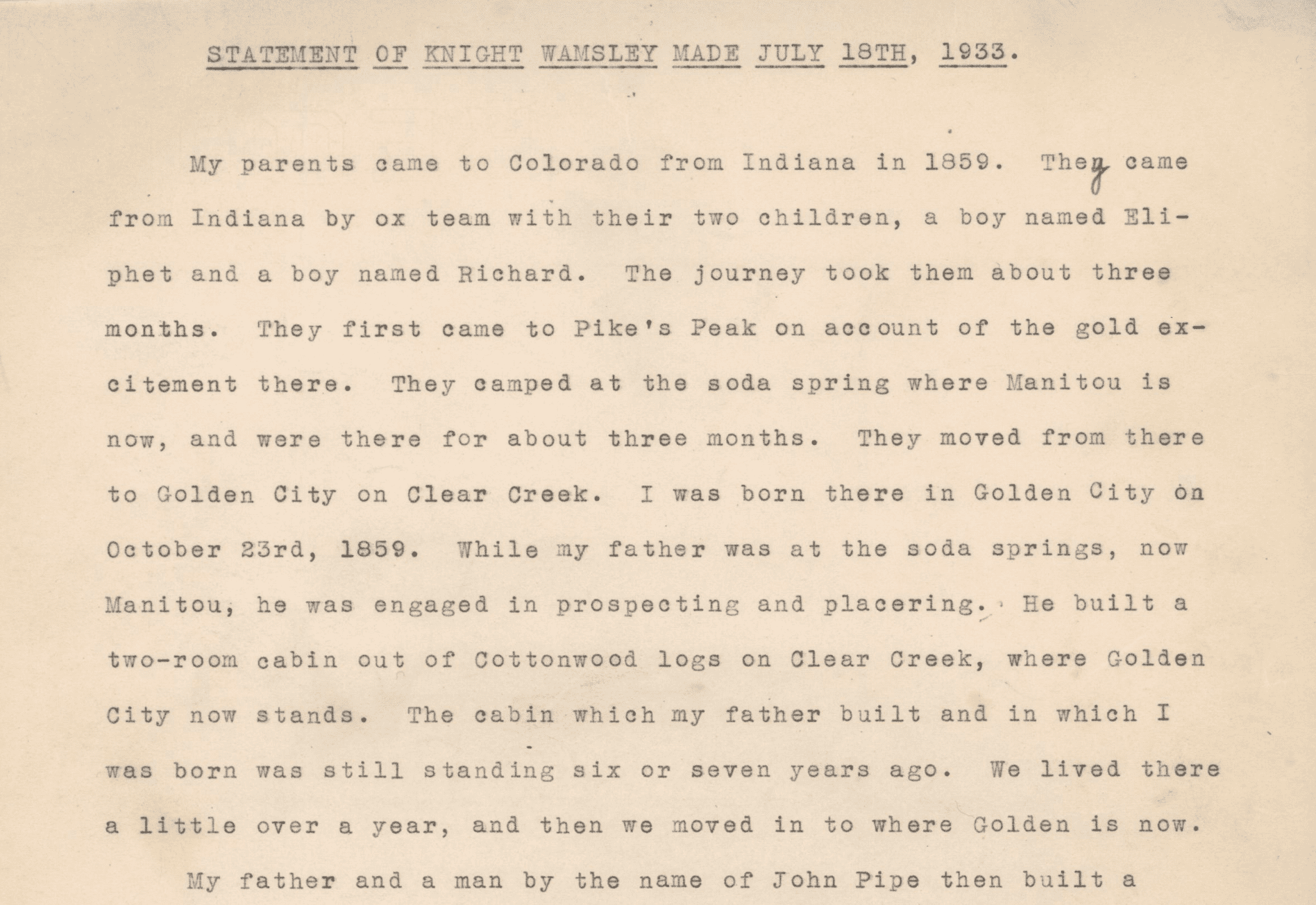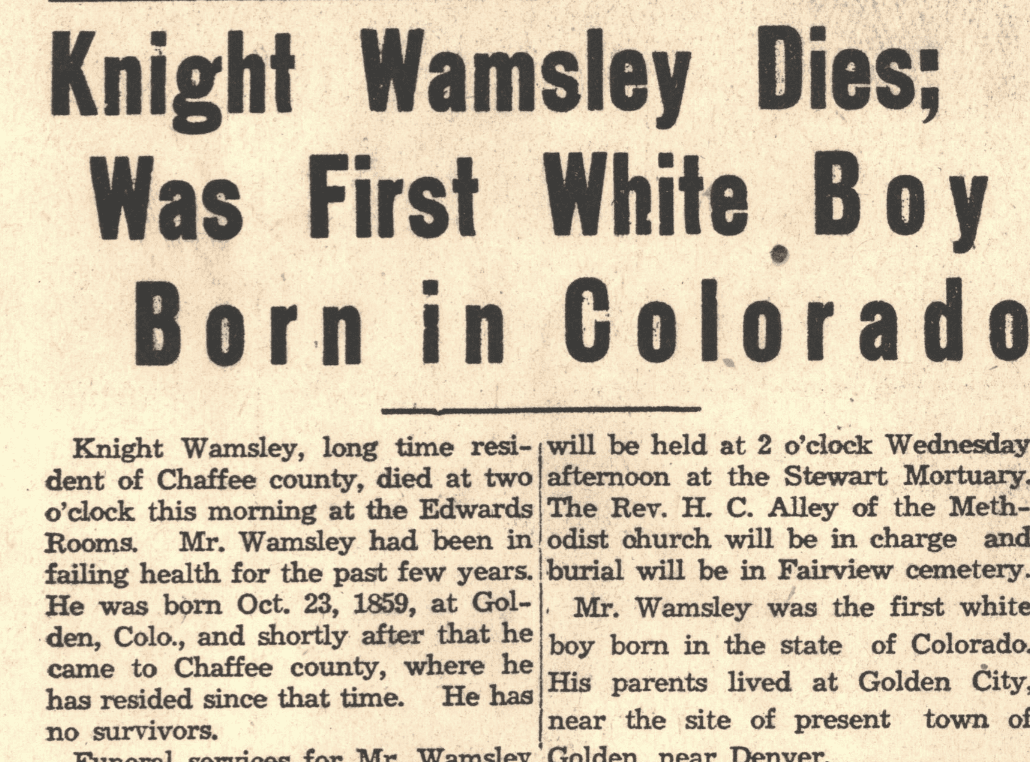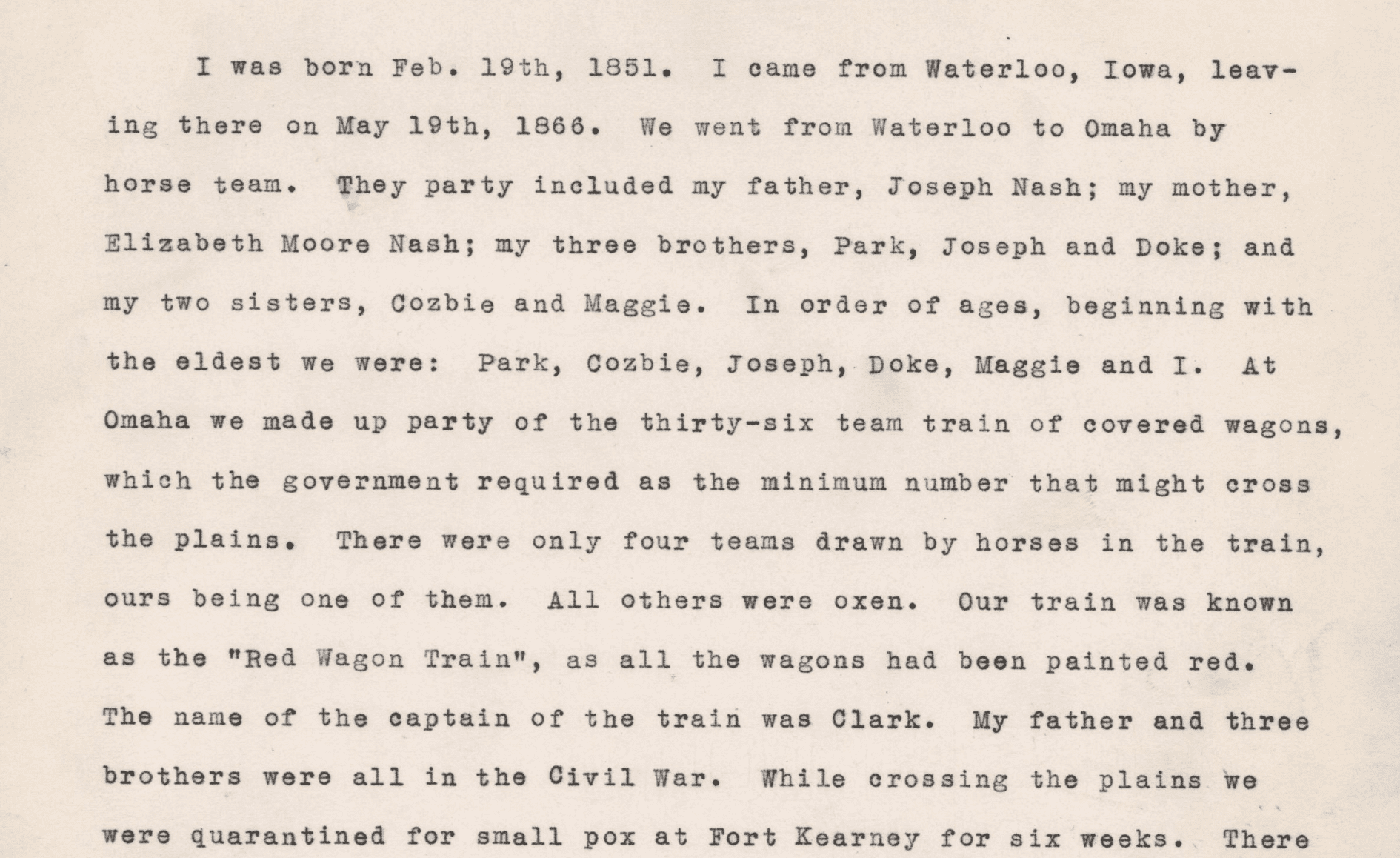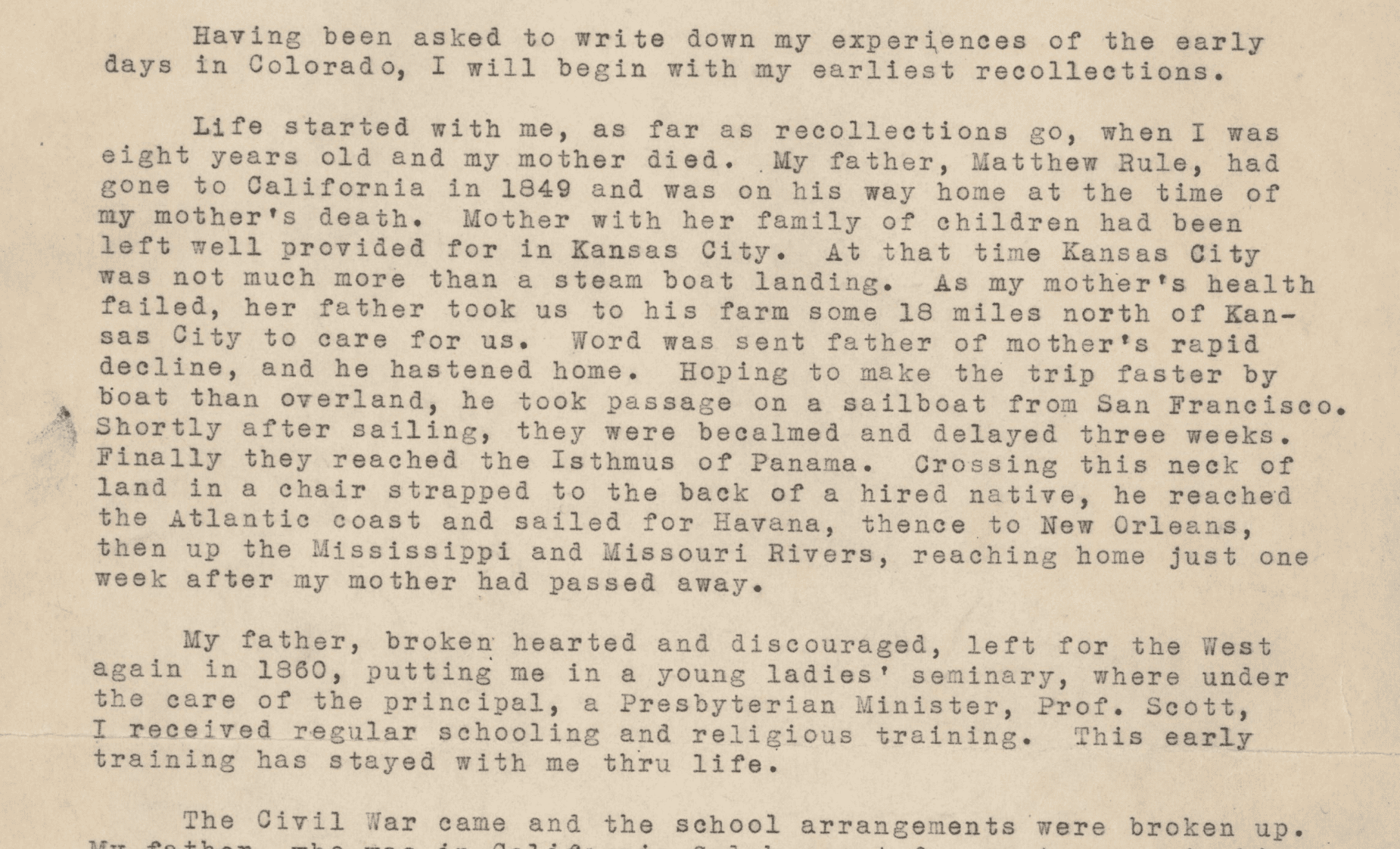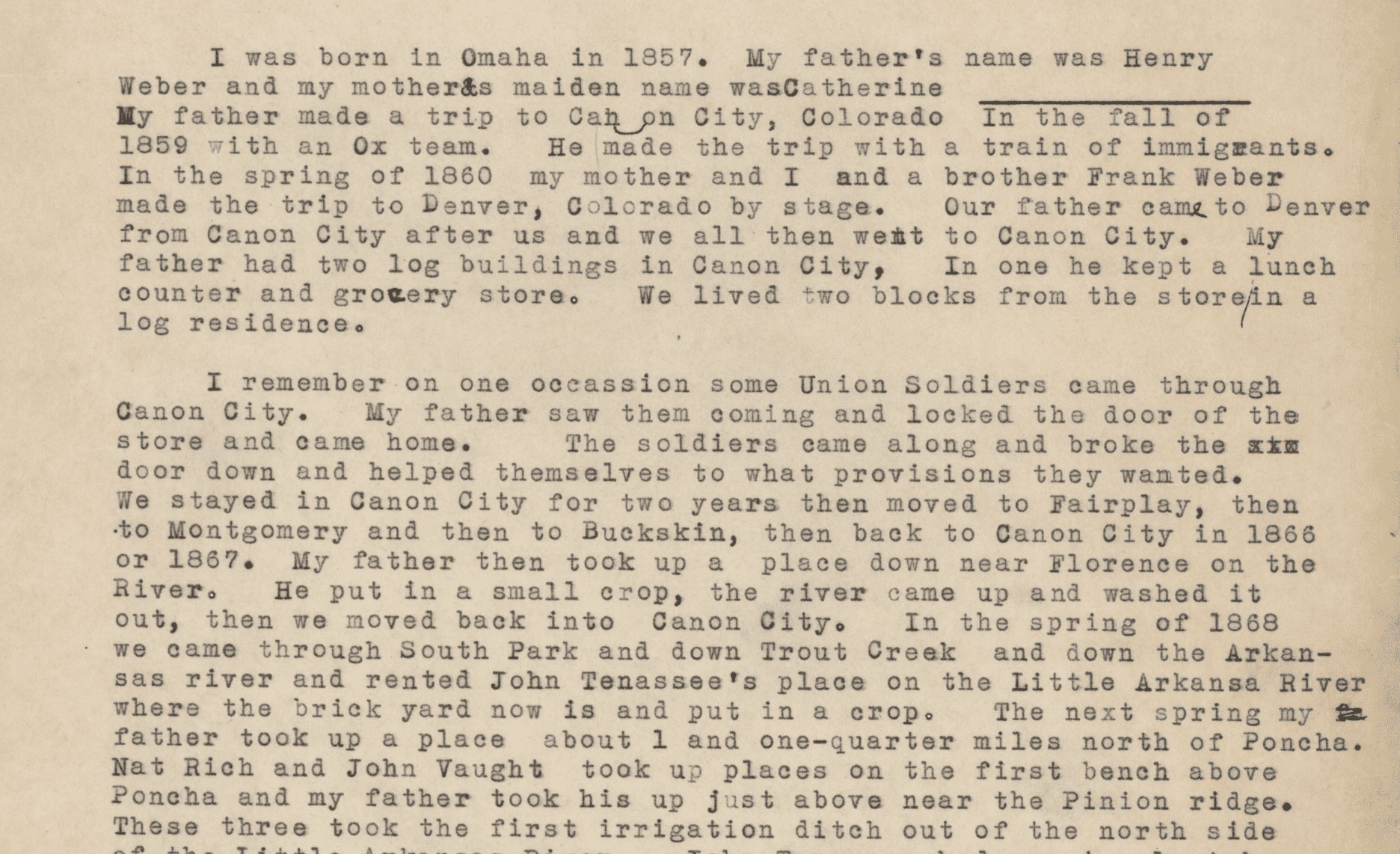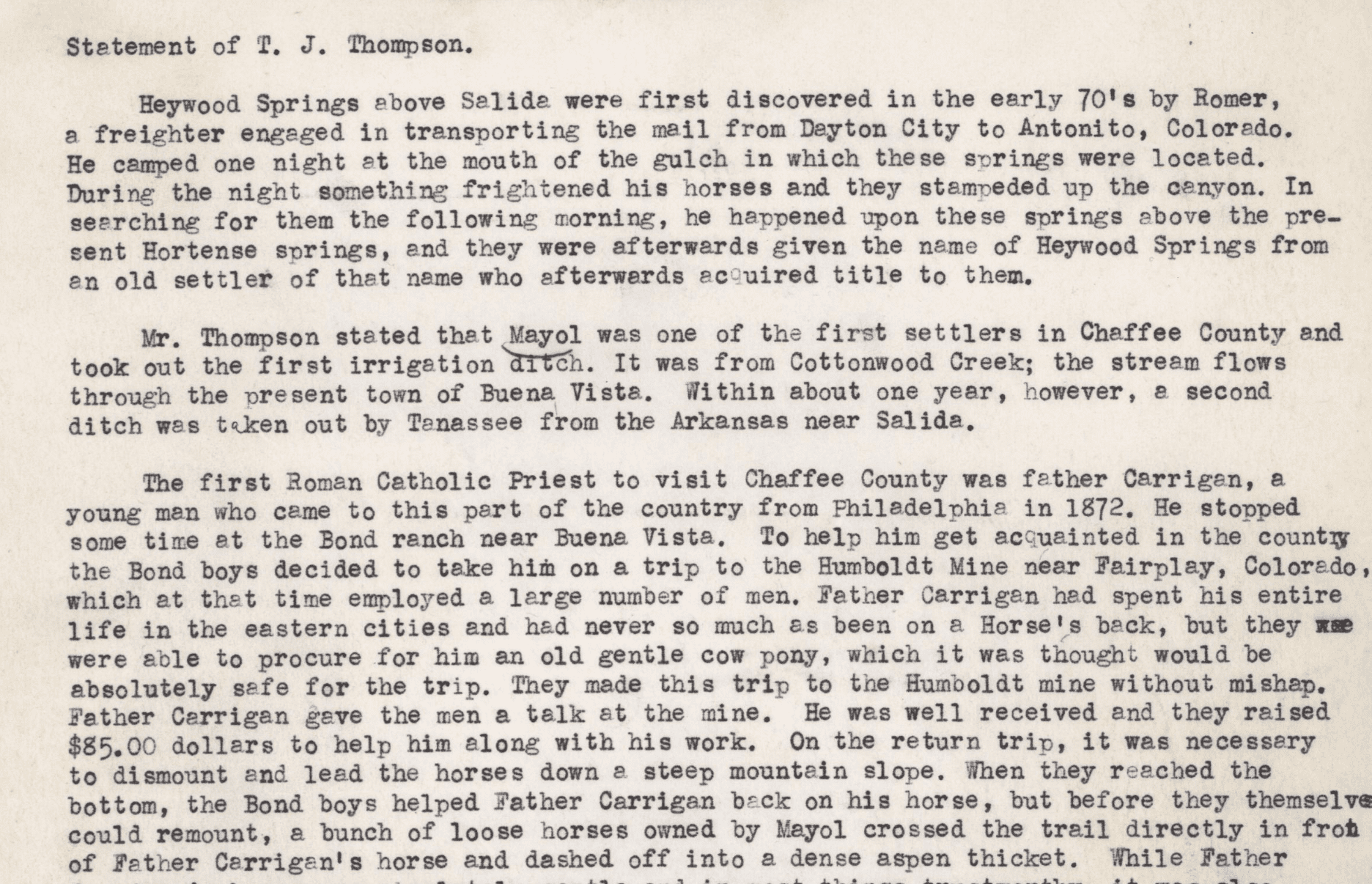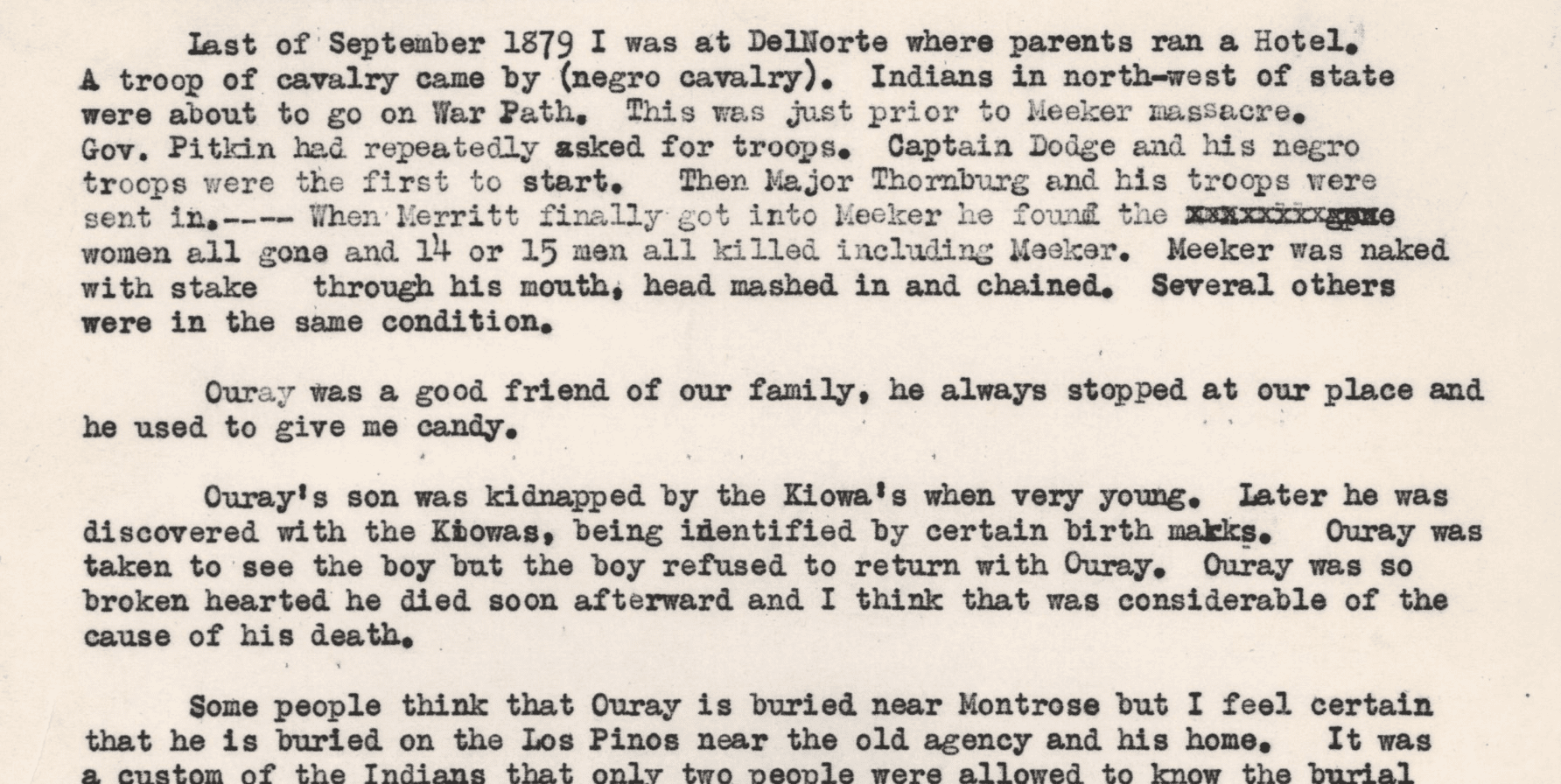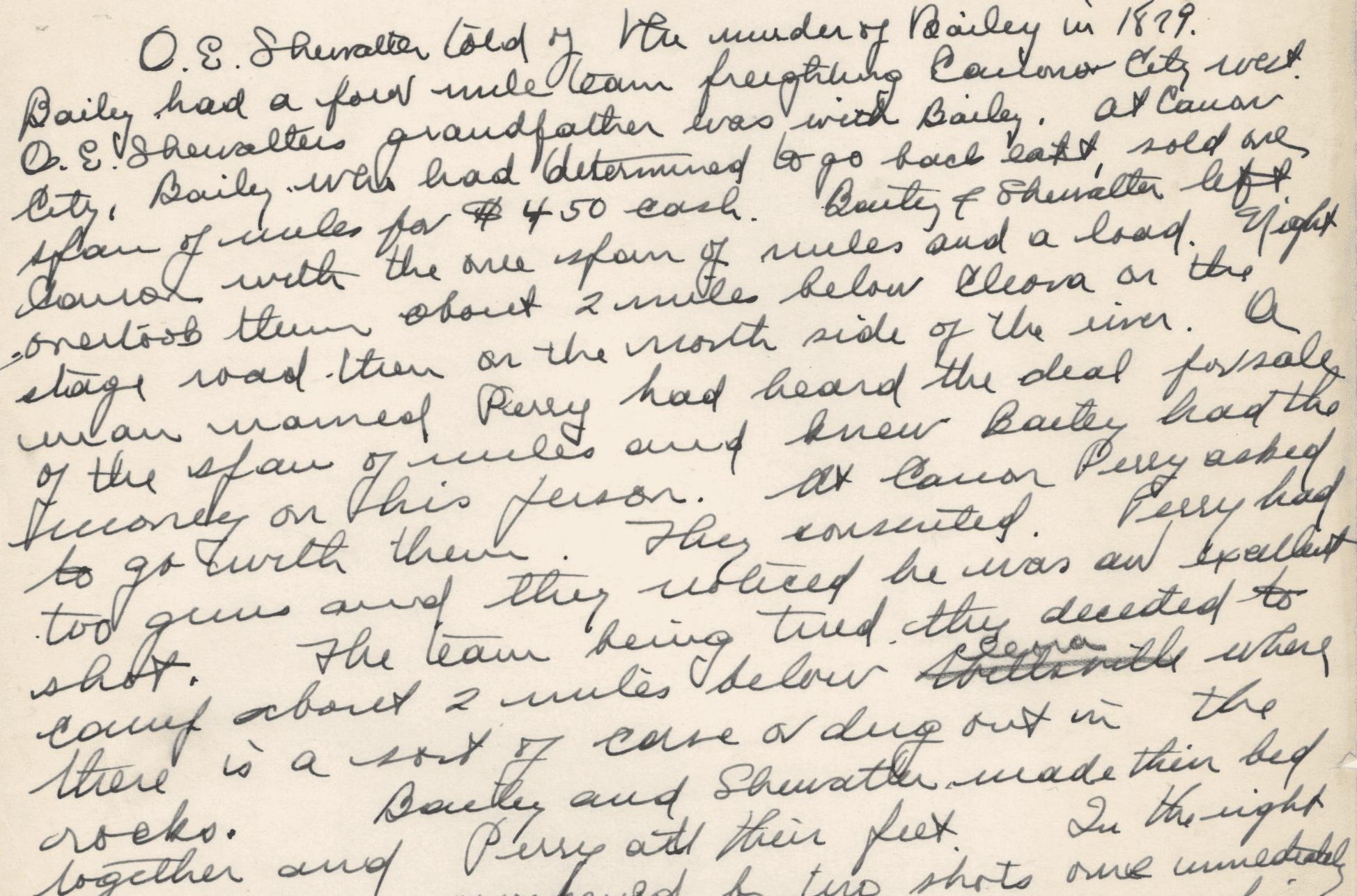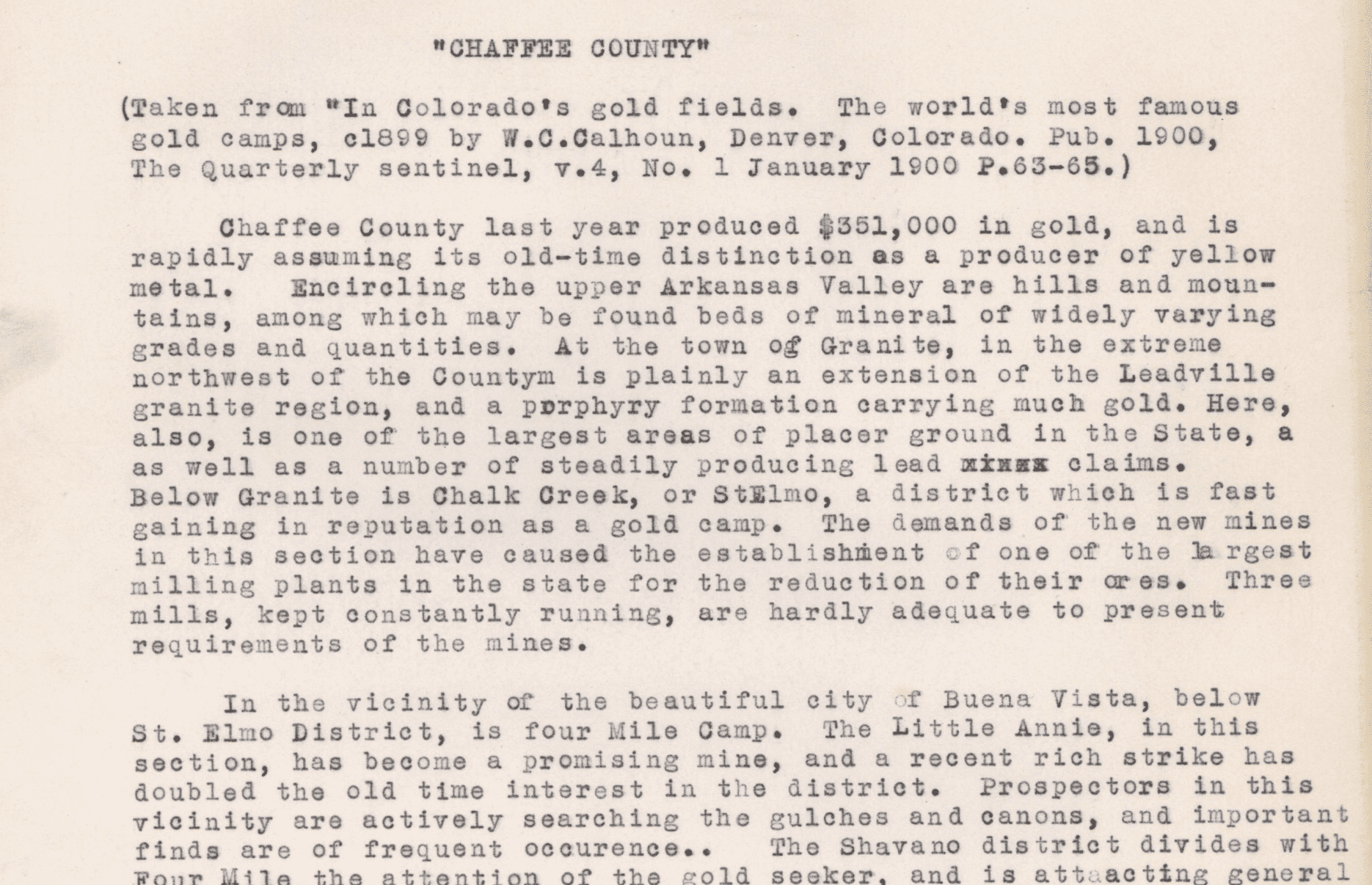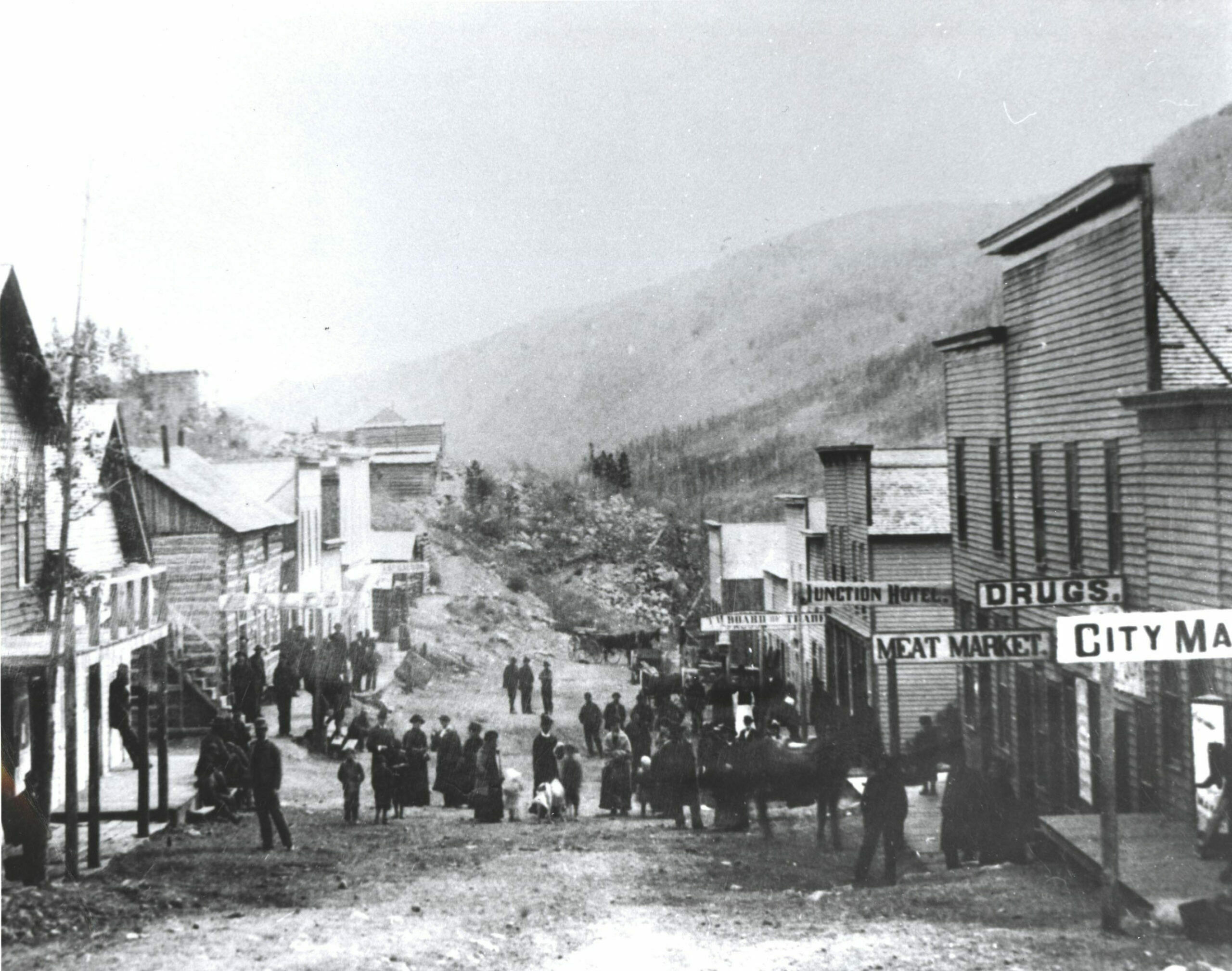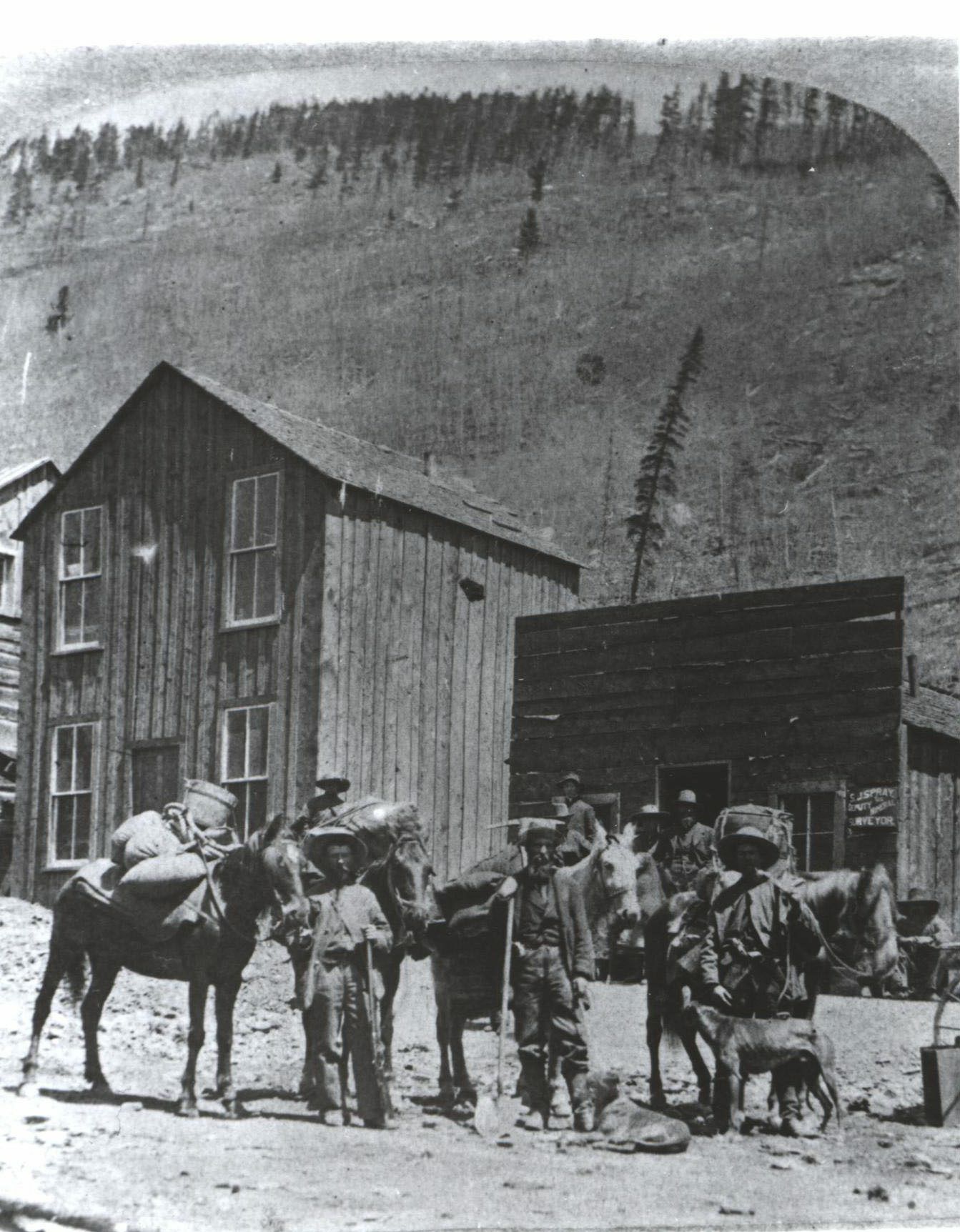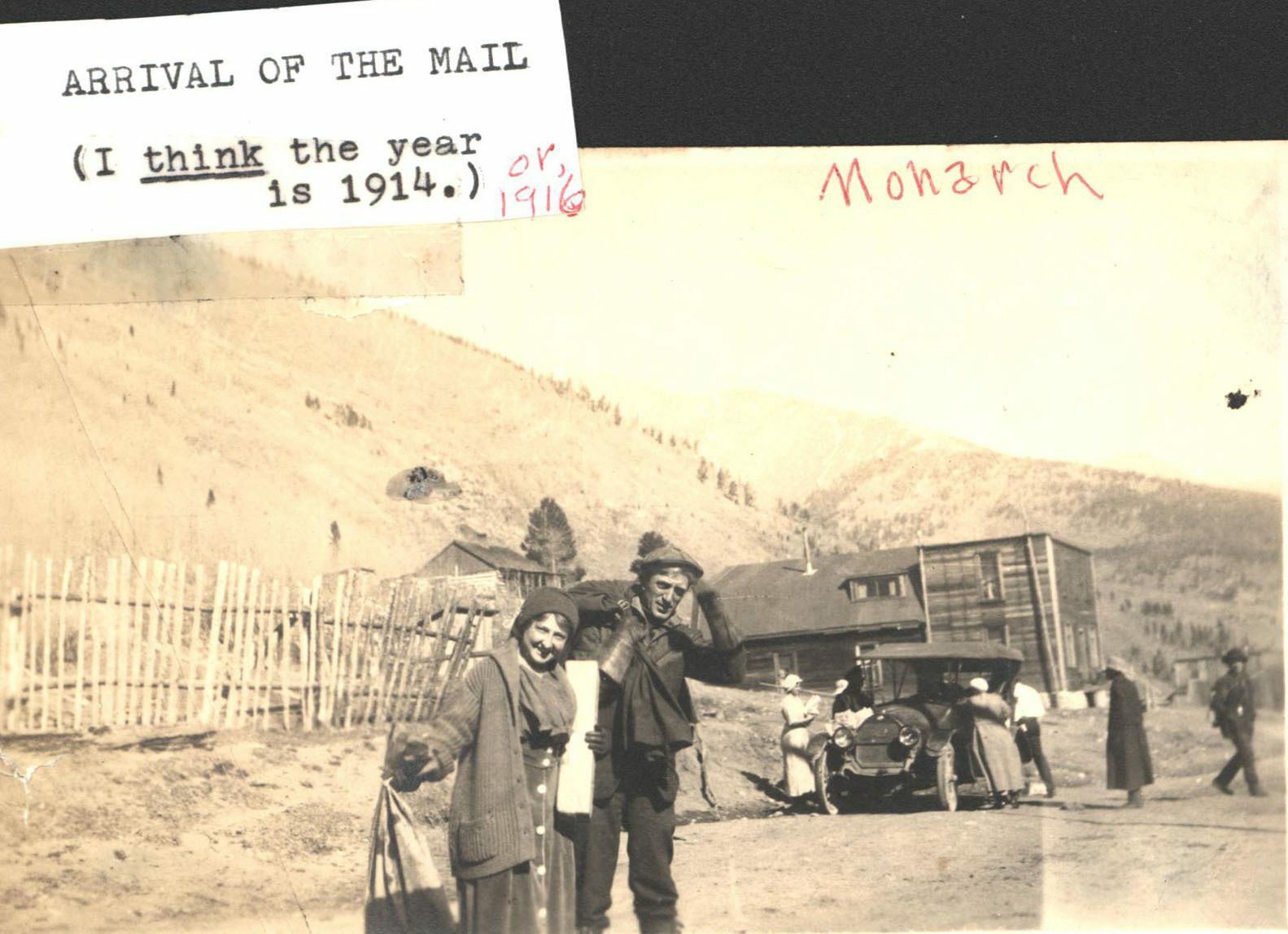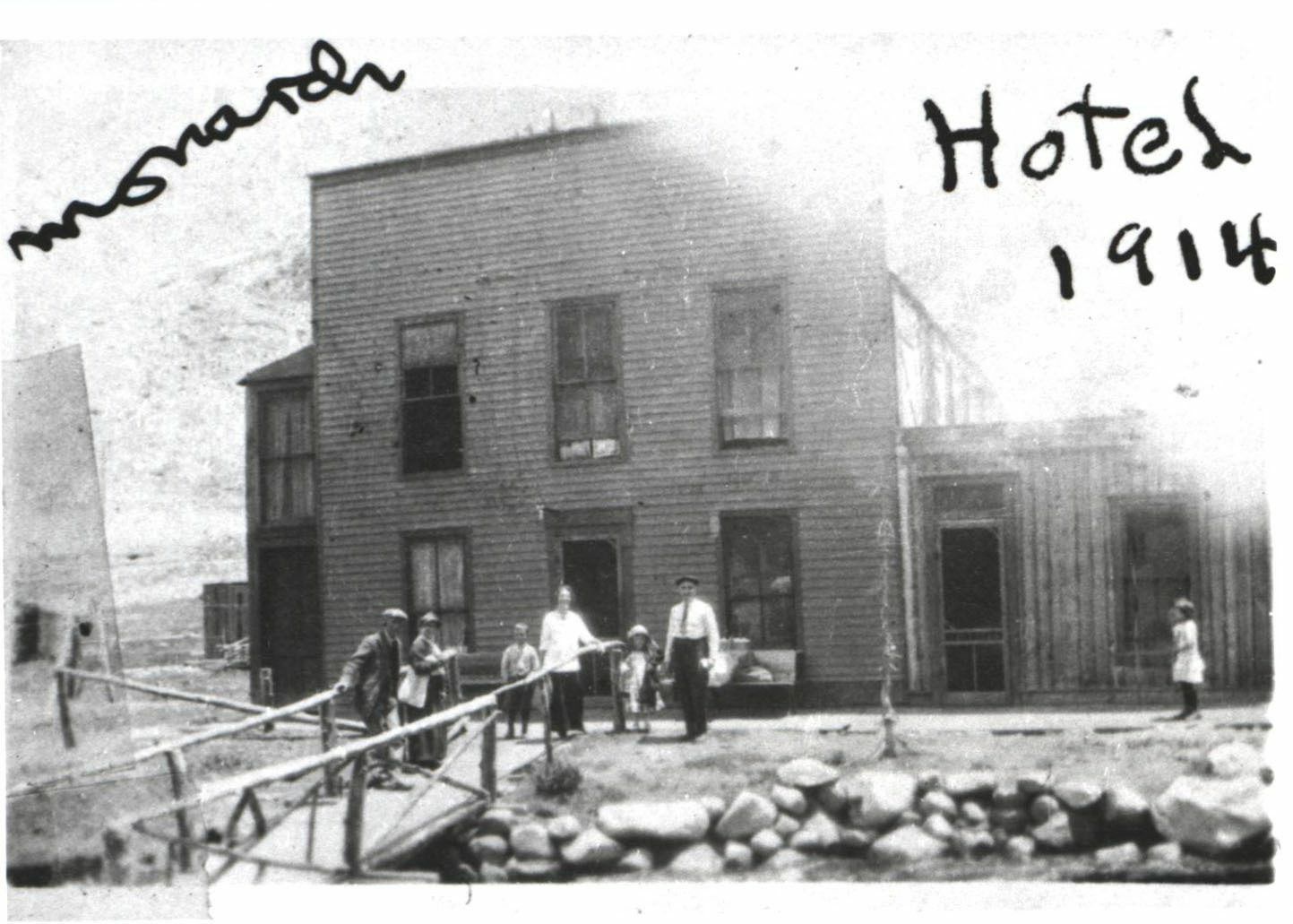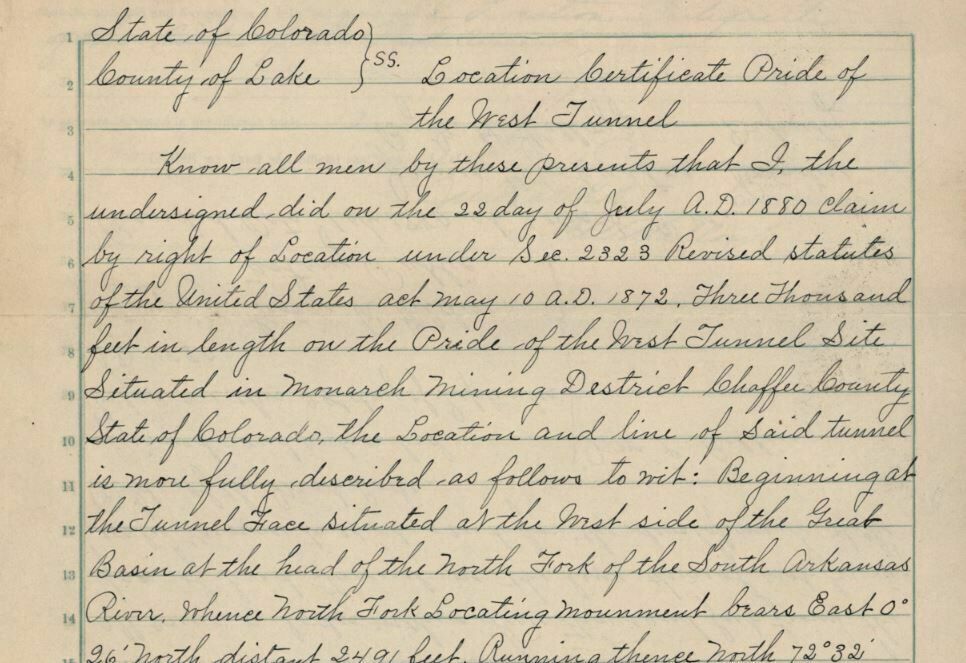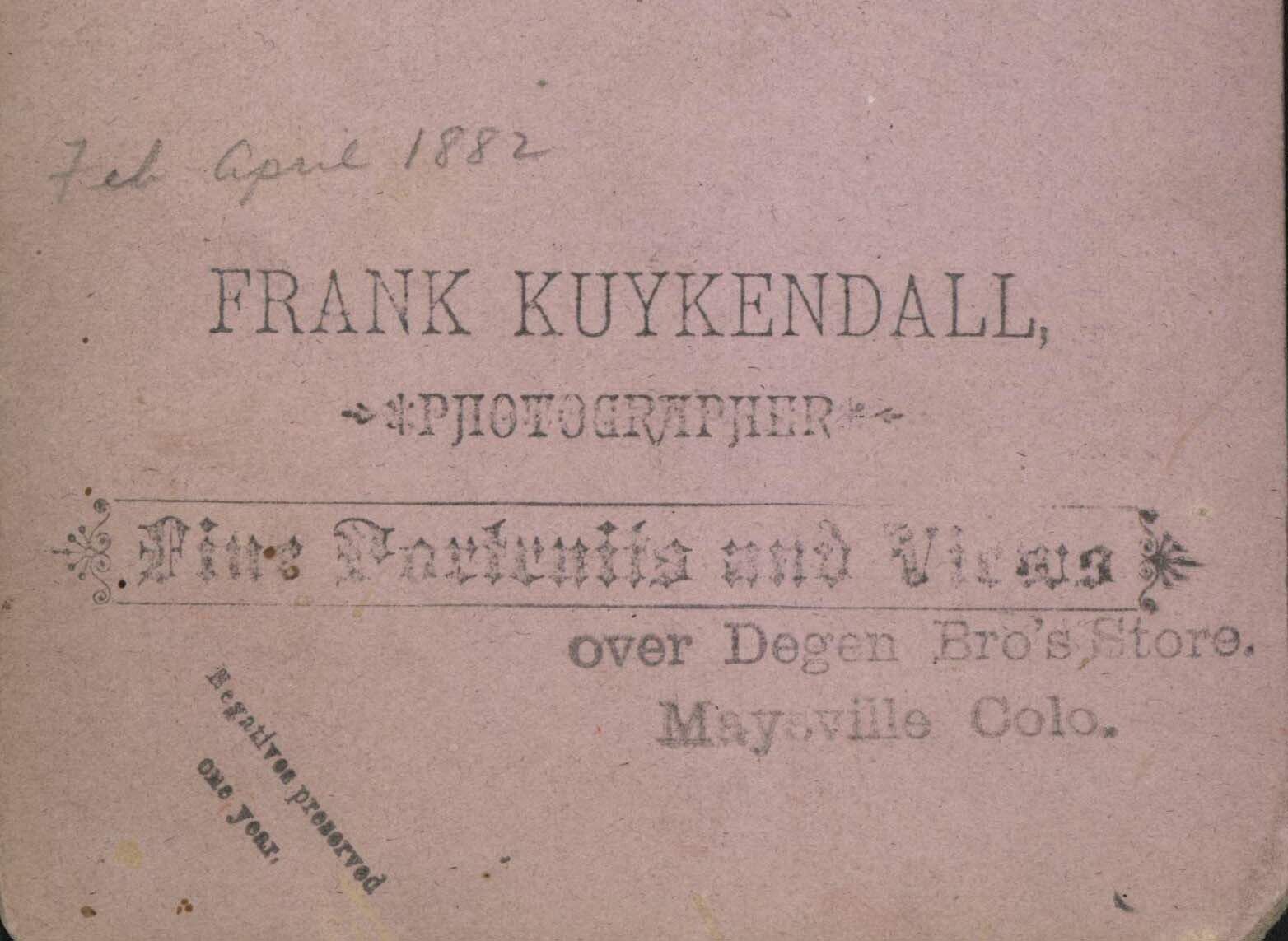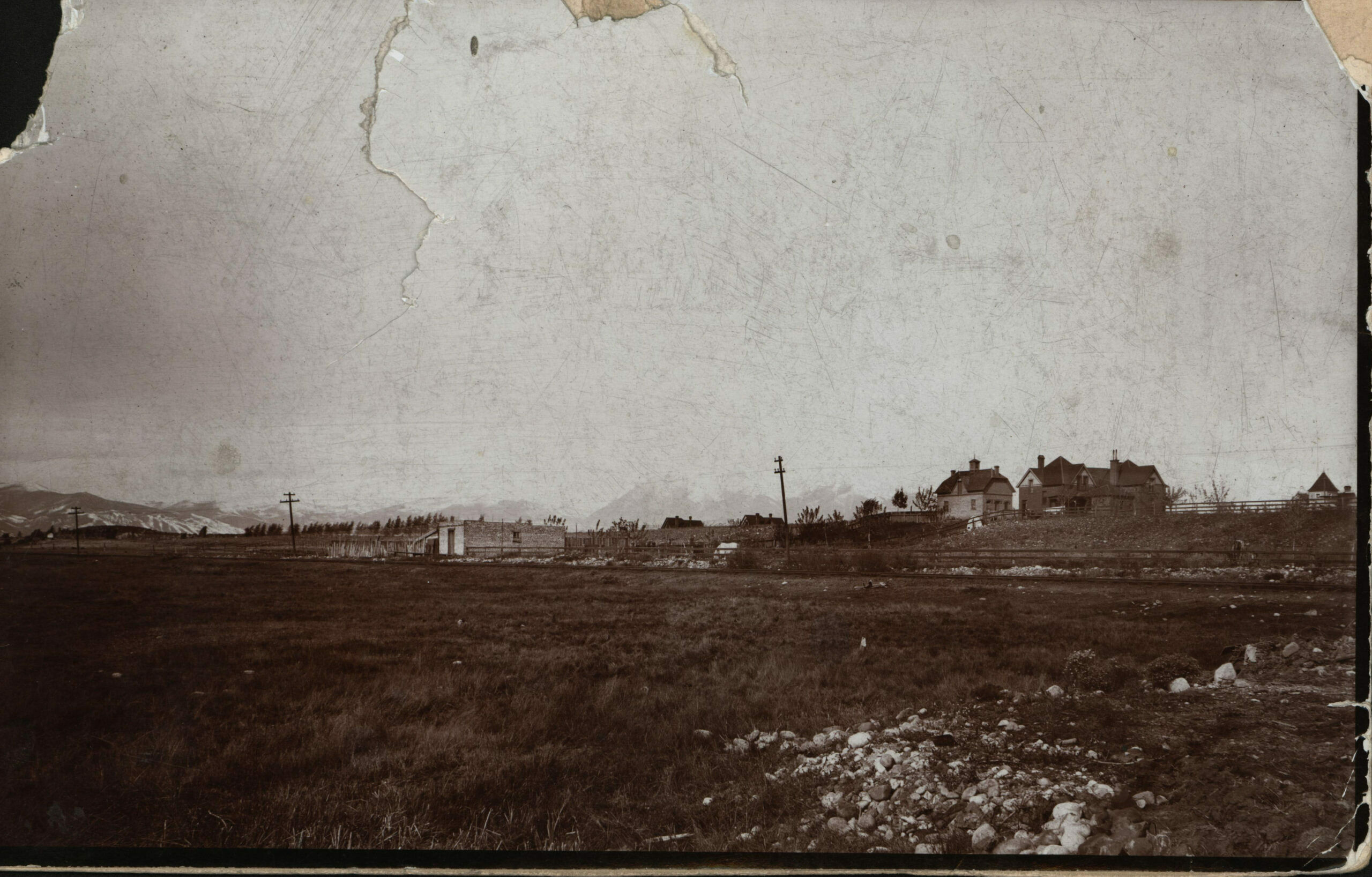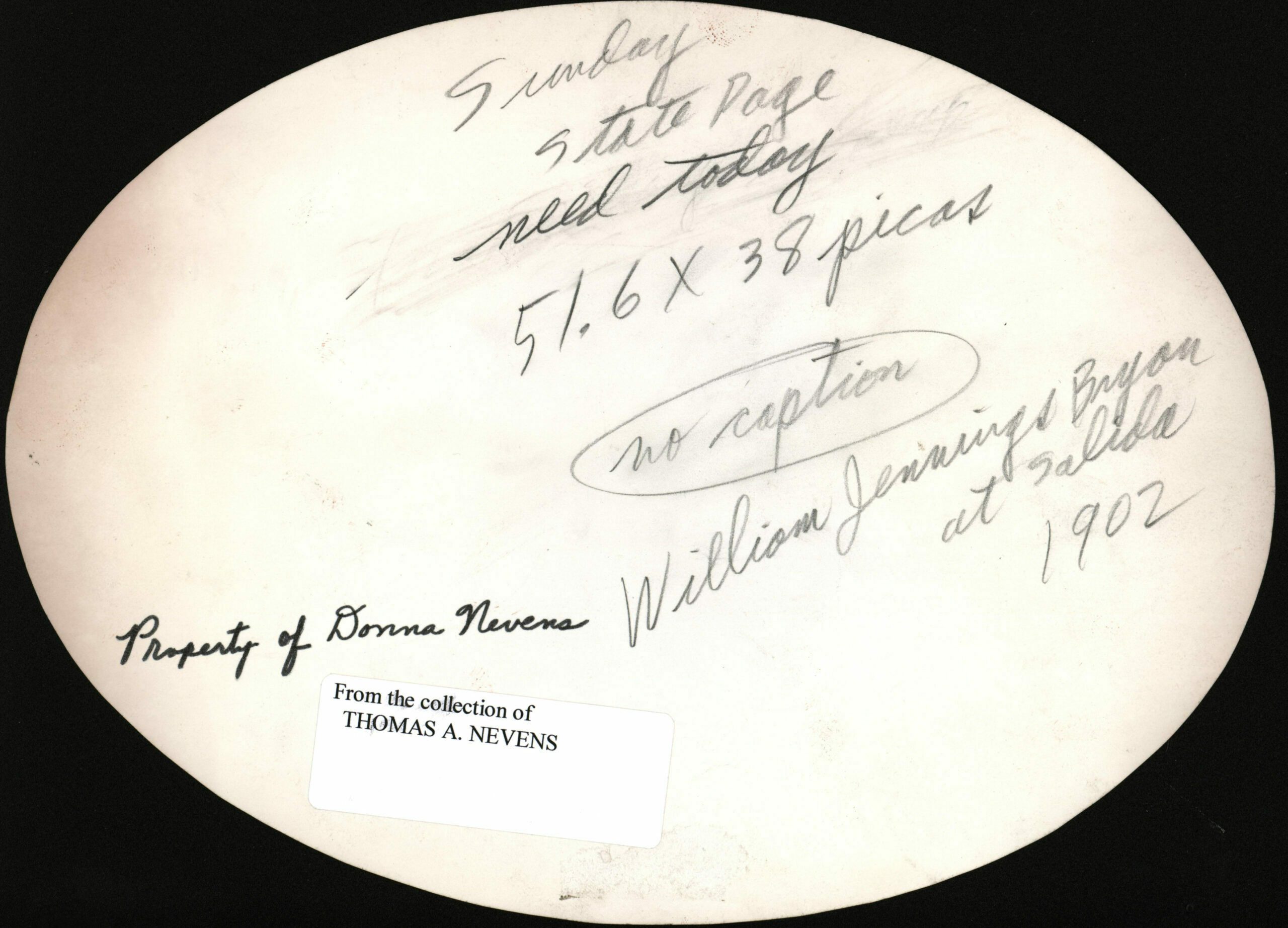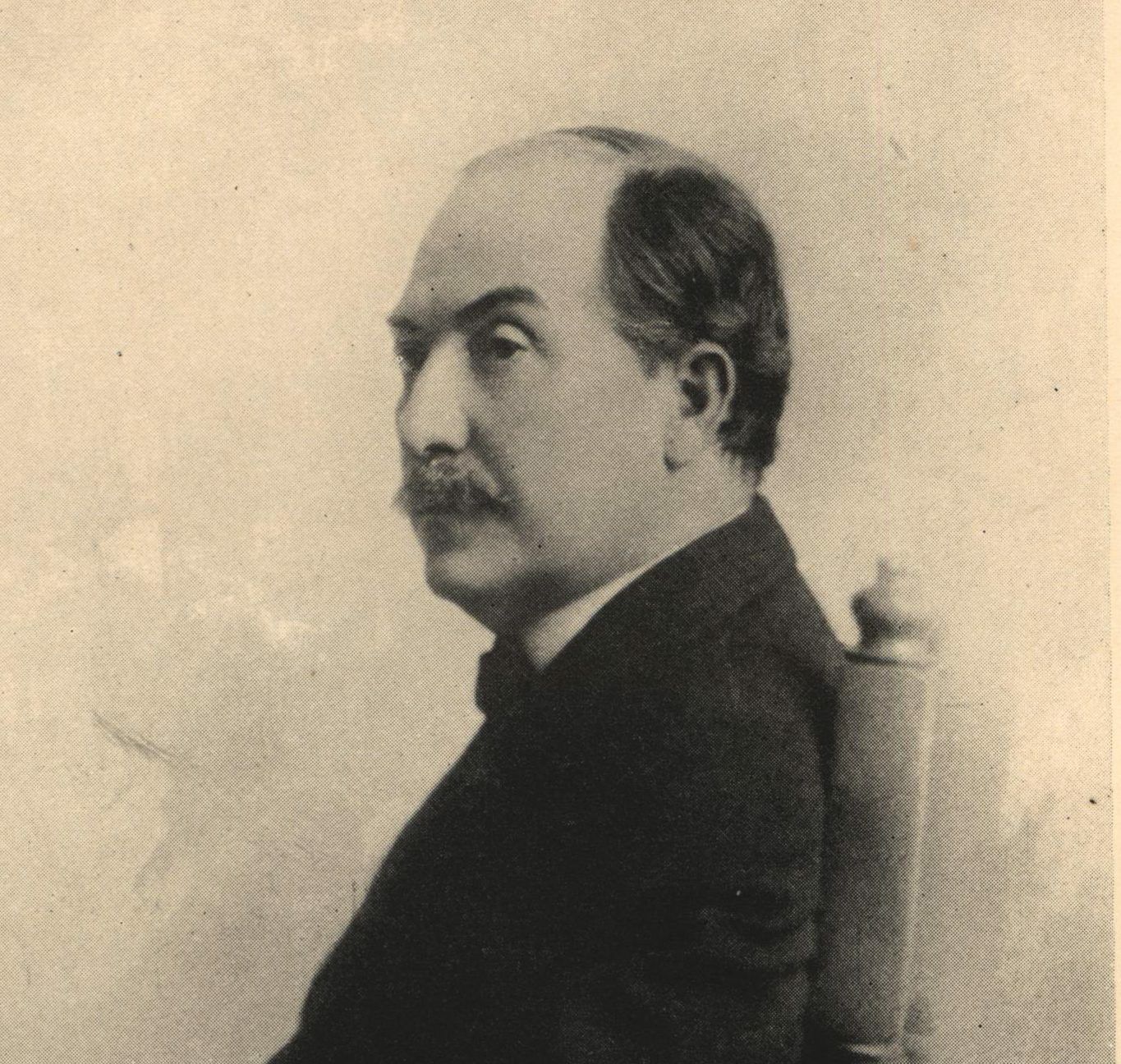Donna Nevens Collection
Donna Nevens was Salida’s premier researcher. She housed an extensive collection of Salida history and put in untold hours researching and collecting the early local history of Chaffee and Lake counties. Back in the 1960s, Donna would go into the Mountain Mail offices (then-editor George Oyler gave her a key to the place) and read newspapers into an audio recorder; then, she would go home and transcribe what she had read. She amassed great quantities of research over a span of sixty years. Donna died in January 2021.
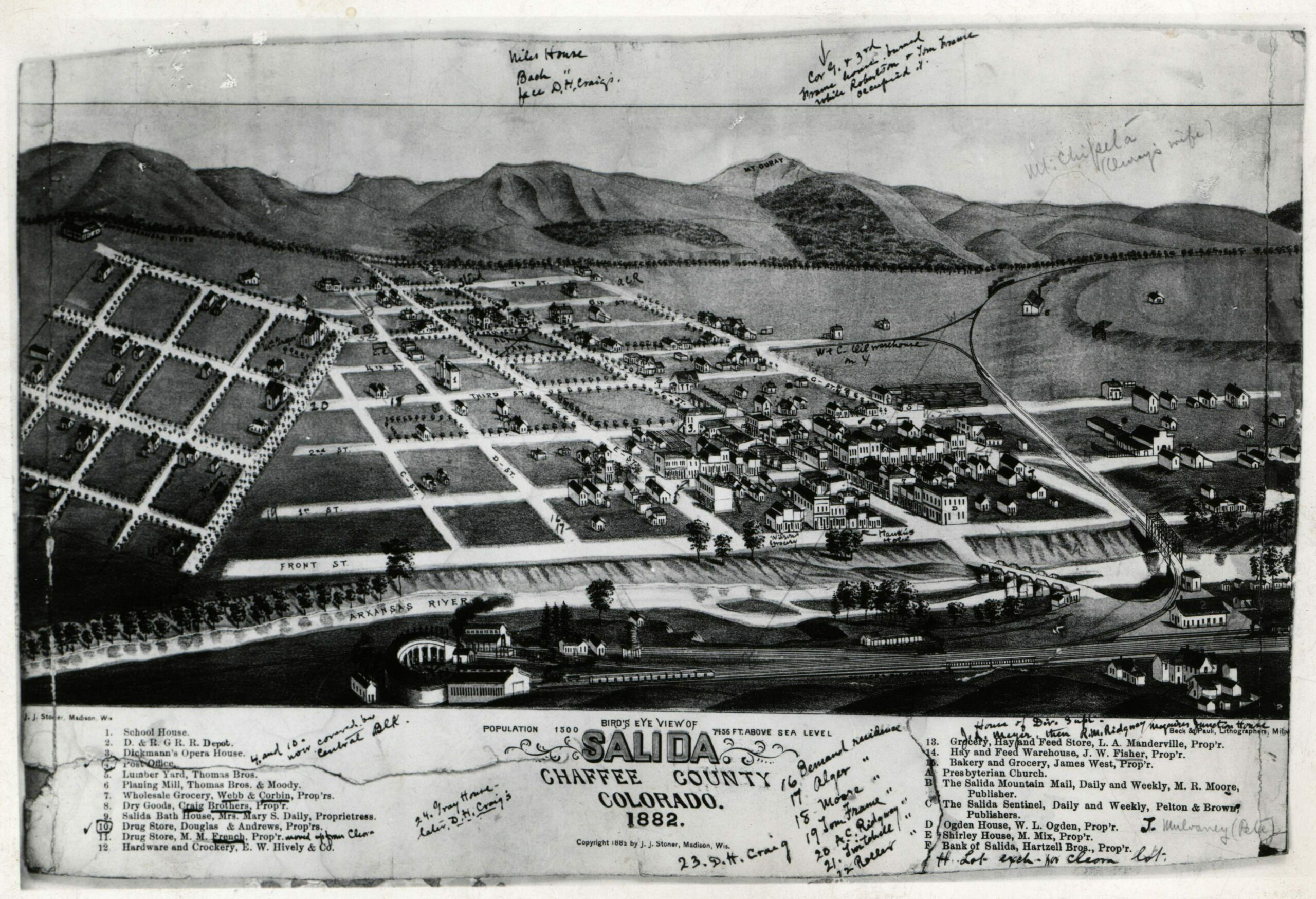
J.J. Stoner’s Bird’s Eye View of Salida, dated 1882. Includes notations by Thomas Nevens.
The Thomas Nevens Papers
Thomas Nevens was Donna Nevens father-in-law. He collected these pioneers statements & narratives before his death in 1945. At least ten of the narratives were included in the book Under the Angel of Shavano by George Everett and Dr. Wendell Hutchinson.
Thomas A. Nevens was Donna Nevens’ father-in-law. He was a prominent city and county attorney for Salida and Chaffee County, Colorado and was also a member of the American Legion Post #64, during the time when Legion led a project to finance and build the Chaffee County Courthouse.
Thomas collected history and interviewed many local pioneers. At least ten of these narratives were included in the book Under the Angel of Shavano by George Everett and Dr. Wendell Hutchinson.
Bancroft's Pioneer Statements
Includes Donna Nevens’ notes; taken from Hubert Howe Bancroft’s History of Nevada, Colorado, and Wyoming, 1540-1888, Vol. 25, 1890. They include Politics and Mining – Town Building in Colorado – Colorado Sketches Statement – Female Pioneering – Salida and Its Surroundings – Indian Troubles of Colorado – The Press and People of Colorado.
Thomas Penrose Statement
Thomas remembers working at the Monarch Mine and the Pride of the West Mine at the Monarch Mining District.
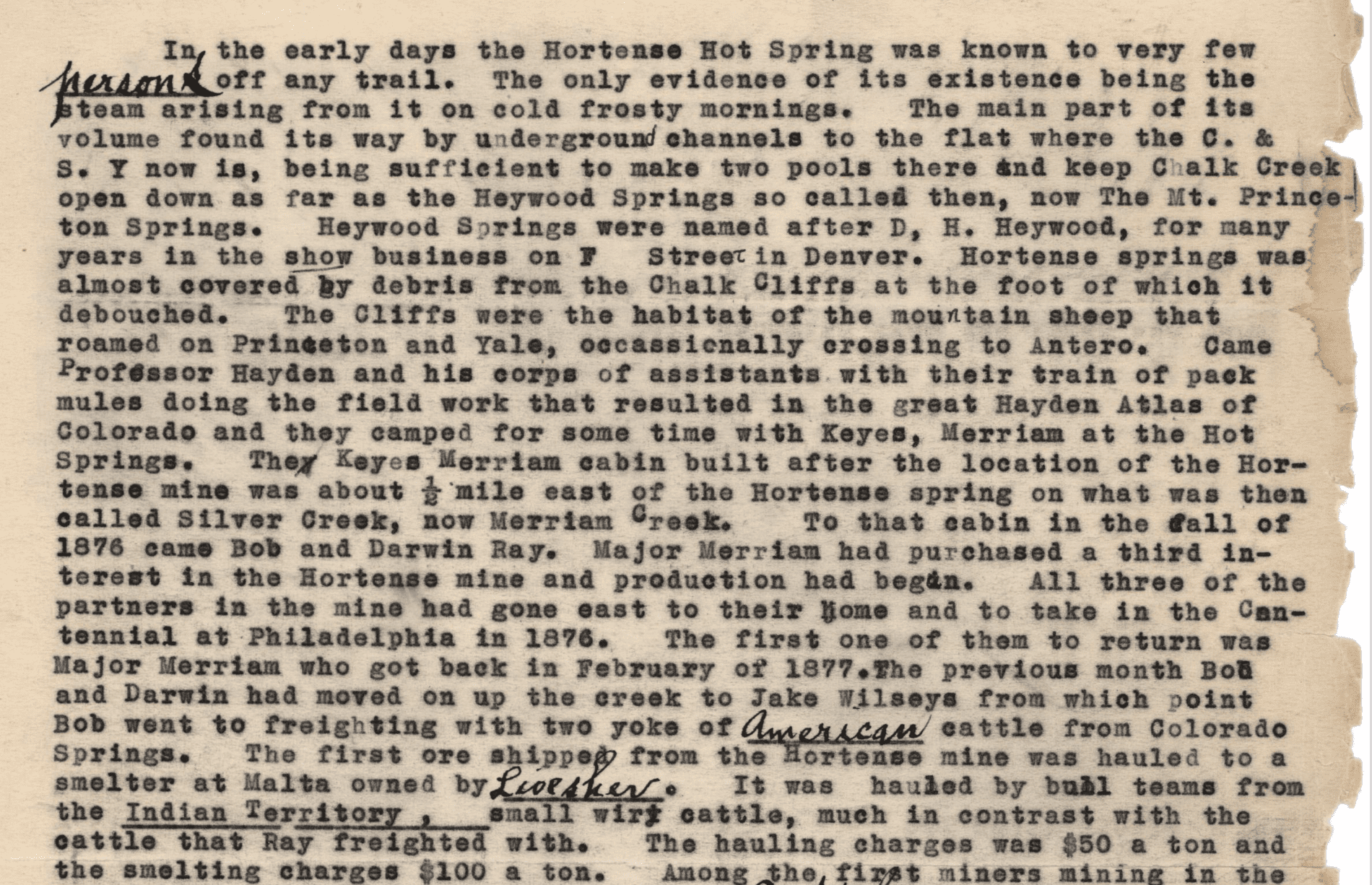
An Anonymous Copy of an Old Paper Written With Pencil by an Unknown Party
This was found by Judge Newitt in his office files in 1931. It is a short history of the Hortense Hot Springs.
Una Hogue's An Indian Chronicle and a Sketch of the Life of Shavano
A history of the Ute Indians, Chipeta & Ouray, and Shavano.
Fred Bateman's History of Salida
History written by Fred Bateman, son of George Bateman, who was a pioneer store owner in Salida.
Fred Bateman's Recollections of Salida
These recollections were written by Fred Bateman, son of George Bateman, a pioneer store owner in Salida.
The following are statements made by Arthur Hutchinson, one of the four sons of Major Joseph and Anabel Hutchinson, who were one of the first families to move into Chaffee County:
Statements and interviews with Hugh Clark Boon, great-nephew to Daniel Boon (aka Boone). Hugh was a Civil War veteran who settled in the Lake County region, before it was Chaffee. He was Cleora’s first postmaster, and was Lake County superintendent of schools. He built the first road (for the mining community) over Monarch Pass and was a miner himself, joining his friend Alex Hogue in mining at Granite, Garfield, and Monarch:
Statement by John Mundlein, Civil War veteran. John was born in Stanton, Virginia, and after serving under Jackson and Lee, he moved to Denver with an ox team. In 1867, he went to Cash (now Cache; near Granite) Creek and set up a blacksmith shop. He lived in Granite for a time and was sheriff of Lake County, Colorado. In 1880, he set up his ranch in Chaffee County and was county commissioner for two terms:
Statement by Knight Wamsley, early Pioneer of Chaffee County. Knight was the first white boy born in the state of Colorado, born in Golden City on October 23, 1959. Knight was a drover in Gunnison, and then on the Mears Stage from Poncha Springs over Marshall Pass. He bounced from South Park to Montana and then back again in the 1880s, and then settled after in Chaffee County until his death:
Account of Mary Nash Mear
Mary Nash Mear’s account of growing up in the upper Arkansas Valley, and her family’s experiences with the local Utes.
Statement of Elizabeth Harrington
Statement of Elizabeth Rule Harrington, the first white woman to arrive in Chaffee County.
Statement of Henry Weber
Includes descriptions of growing up near Cache Creek near Leadville and Granite, and life around the Monarch Mining District.
Early Days in Chaffee County
T.J. Thompson’s description of life in Chaffee County in the early 1870s.
Reminiscences of an Old-Timer
This statement by Judge Joseph Newitt is an essay of the early days of Chaffee County, including a list of the ‘old cranks’ who founded the city of Salida and a letter from George K. Hartenstein.
Notes on the Statements of Joe Cuenin and Arthur Hutchinson
Taken at the meeting of the Chaffee County Historical Society, June 1942.
The Murder of Bailey
As told by O.E. Shewalter. Also included are the stories of the killing of Radcliffe and how Tug Wilson rescued two children from a Ute war party.
The Statement of M.N. Jordan
Reminiscences of living in Saguache, Colorado.
"Chaffee County"
Taken from ‘In Colorado’s Gold Fields: The World’s Most Famous Gold Camps, pub. 1899 by W.C. Calhoun, Denver, Colorado. Pub. 1900, The Quarterly Sentinel, Vol. 4, No. 1, January 1900, pages 63-65.

The Town of Garfield
The town of Garfield was first known as Junction City and then after as Monarch, before staying with Garfield. It is located between Maysville and Monarch Pass, near the South and Middle Forks of the South Arkansas River in Colorado. Garfield had a post office from 1880-1889, and then again from 1905-1911.
Garfield suffered a catastrophic fire in 1883. A barrel of gunpowder exploded at Farrel’s Saloon and the entire town burned to the ground.
Garfield. Note the shingle advertising S.J. Spray, deputy mineral surveyor for the town of Garfield. He was listed in the Colorado Business Directories for 1882-1884. The town of Garfield (formerly Junction City) is not listed before 1882. S. J. Spray was the husband of Ruth Spray, Tuesday Evening Club member.
From the State Historical Society of Colorado, part of Donna’s Collection.
A Chaffee County Times typescript of the mining action that was happening in 1881.
First known as Junction City, then (somewhat erroneously as) Monarch, and finally Garfield, it is located at the south and middle forks of the South Arkansas River up west towards Monarch Pass.
The Town of Monarch
Nicholas Creede struck ore and named his claim ‘Monarch’ which eventually became the little town of Monarch, located a mile or so above Garfield, Colorado.
In 1878, on the western edge of Chaffee County, prospector Nicholas Creede struck ore and named his mine ‘Monarch.’ Prospectors soon came from all over to try their luck, and the town of Chaffee City was born. To lessen confusion, the town was renamed Camp Monarch in 1879, and then just Monarch.
Monarch was located about a mile west of the town of Garfield and had mining camps all over. When the 1893 Silver Panic hit, the town took a hit. Today the Madonna Mine is the last vestige of Monarch.
The following images are of the Monarch Hotel.
Pride of the West Mine
This mine was located up the North Fork of the South Arkansas, near the North Fork Reservoir.
The Pride of the West mine is located at the end of the North Fork of the South Arkansas. William L. Billin managed the North Fork Consolidated Mining and Tunnel Company, which operated the Pride of the West lode. Thomas Penrose wrote in his statement:
‘When the arch was built at the Pride of the West Tunnel, an Irishman by the name of Regan was the chief stone mason, and as I had been born and raised in the Parish of St. Agnes in Cornwall, and as a man by the name of Bennett was working there at the time who also came from St. Agnes, he got a quart bottle of beer and threw it at the arch and christened it ‘St. Agnes’ at the time it was finished.’
In 1882, several lawsuits were filed against the company for goods and services provided to the company. One suit was filed by a local bank for over $4000 owed on a loan to the company. Here is the July 8 Complaint and the July 13 Complaint. A Writ of Attachment was executed by the Sheriff on all real and personal property, including all buildings. Another suit contained amounts due to five Maysville merchants for goods and services. In 1884, the company defaulted on promissory notes and the company’s mines, buildings, and personal property were sold at auction in Philadelphia. As a result of another local lawsuit, another Writ was executed by the Sheriff in March 1887 and various items were sold at auction.
The Shavano Band. Thomas Penrose is 4th from the left. This photograph was taken near the Billings Tunnel ca. 1880s.
‘While working at the Billings tunnel, we had a brass band consisting of about ten or twelve pieces. We came down to Maysville for the Fourth of July celebration with the band, played for a picnic there, and received $150 for our trouble. Kid Vernon, who had a livery stable at Maysville, and was later killed by Wilson, was sent for to bring the band down from the tunnel to Maysville. Maysville was booming at the time, and was probably about at its best. There must have been over a thousand people living in Maysville at the time….From Maysville, Kid Vernon took us down to Poncha. There Major Hulbert invited us to dinner and after that we played some on the street, and from there went to the favorite saloon which was across the street from where Appleby’s store is now. We went back to Maysville that night, and as there was a big dance on at the Knight’s of Pythias Hall, we were called on there to play some more. Bill Shaw was in Maysville at the time, and was at the dance, which, of course, lasted all night.’
– from the statement of Thomas Penrose
Town of Shavano
This town was located up the north fork of the South Arkansas River. It was founded in 1879 and only lasted for a few years.
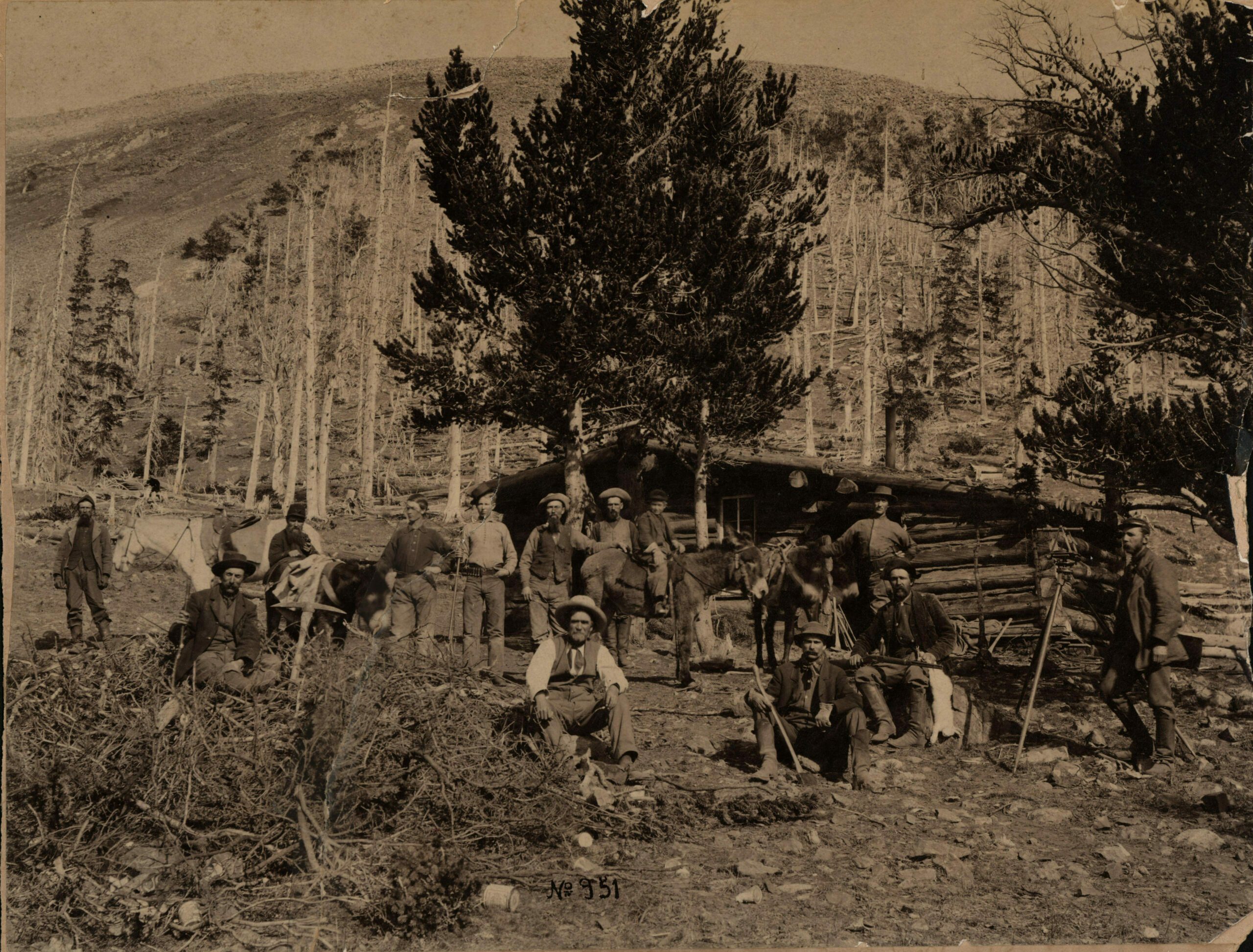
Town of Maysville
In 1879, the site of Maysville was ranch land owned by Amasa Feathers. By 1880, the town was platted and had a population of around 1000.
The following photographs are of Maysville in the early 1880s. Backs of each photo are to the right.
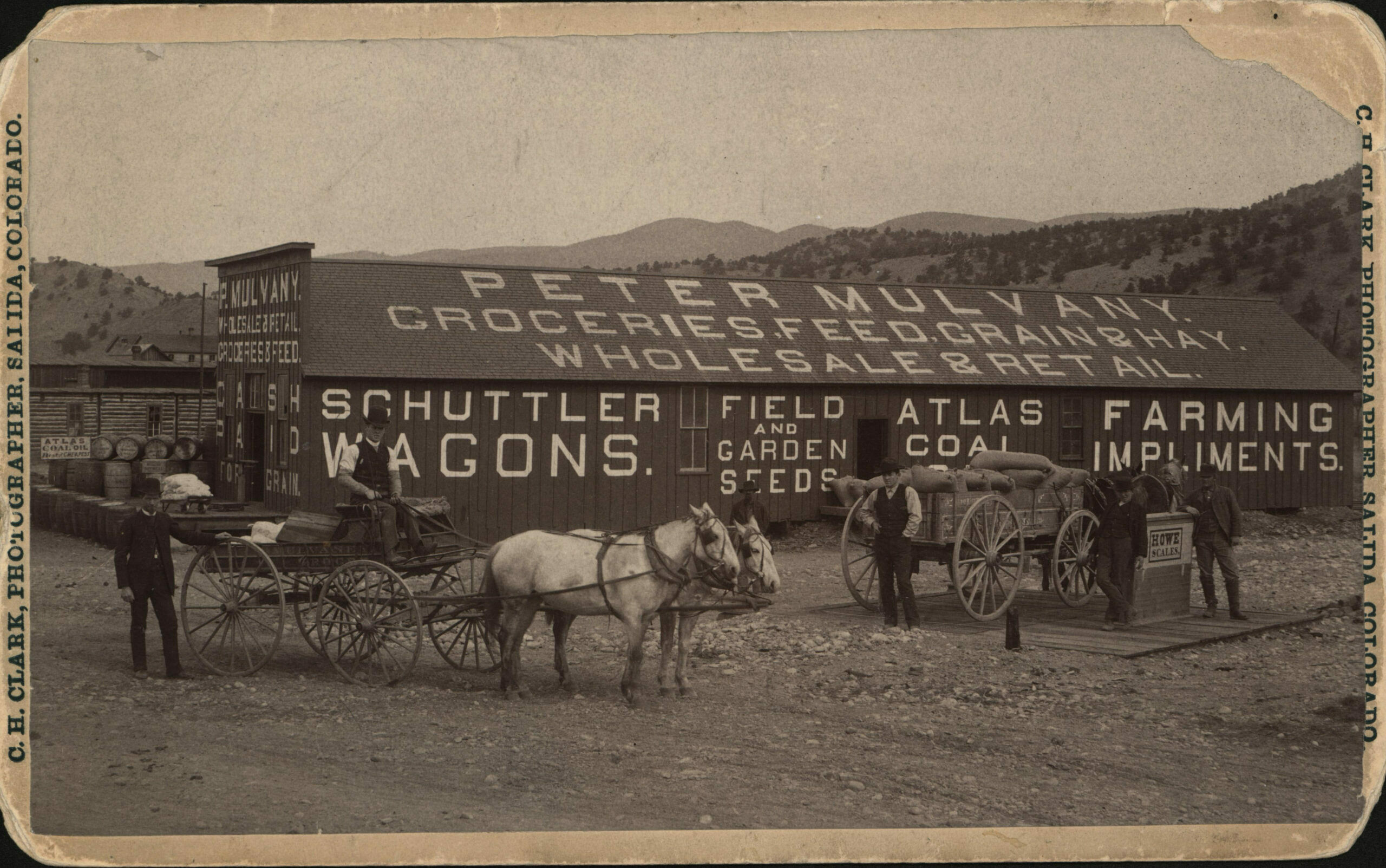
Peter Mulvany
One of Salida’s first successful businessmen, he prospered, and struggled in the 1880s and 90s. He suffered a terrible string of bad luck when fires burned his businesses, four in the space of 20 months.
Photo of the Mulvany property on the Mesa. Taken approximately where 7th Street intersects the Monarch Spur Trail.
T.J. Hampson
Thomas Jefferson Hampson was a miner in the Garfield area of Chaffee County, Colorado, during the 1880s and owned a grocery store with his brother here in Salida.
Dates sourced from the Salida Mail:
1885 – 1/2, 1/15, 1/31, 6/26, 12/11
1886 – 9/3, 9/10, 10/15, 11/5, 11/12, 12/2, 12/10
1887 – 4/8, 4/22
1888 – 1/20, 2/17, 3/30, 4/6, 5/11, 6/8, 6/15, 7/27, 9/18, 11/27
William Jennings Bryan
Image of William Jennings Bryan delivering a speech from the back of railroad car in Salida, Colorado, on October 28, 1902.
Back of image is seen below:
American orator and politician, Bryan was in Salida on October 28, 1902 and delivered a speech from the caboose of a railcar in the Denver & Rio Grande rail yard.
Photograph of William Jennings Bryan delivering a speech from the back of railroad car in Salida, Colorado, on October 28, 1902.
E.D. Cowen
Newspaperman for the Leadville Daily Herald during the 1880s. Ed Cowen wrote a great series of editorials detailing his tour of the mining region in the Monarch area, paying particular attention to the town of Maysville.
Edward Cowen was an editor for the Leadville Daily Herald in the 1880s. He wrote amazingly descriptive articles and was a great storyteller, but he had very little primary education.
‘His command of pure English was extraordinary. It was a delight to read what he had written even on a prosaic subject.
As a raconteur, he was charming.‘
— from Newspaper Career of E.D. Cowen with Biographic Sketches by Charles A. Murray, et al., Western Printing Company, Seattle, 1930.
The following are typescript copies (made by Donna) of Cowen’s articles for the Leadville Daily Herald:
~ Town of Salida ~
Portions of Minutes of the Board of Trustees
1879 – 1897
Portions of Minutes of the Board of Trustees
1879 – 1897

